#200 films of 1952 film 54
Explore tagged Tumblr posts
Text

Day 55- Film: Penny Princess
Release date: August 25th, 1952.
Studio: Conquest Productions
Genre: Come
Director: Val Guest
Producer: Earl St. John, Frank Godwin
Actors: Dirk Bogarde, Yolande Donlan, Reginald Beckwith
Plot Summary: The European microstate Lampidorra, situated between France, Switzerland, and Italy, is about to go broke. A wealthy American businessman offers to buy the whole country, but just when all the papers are signed, he drops dead. After a long search for any of his heirs, they settle upon Lindy Smith, a Macy's shop-girl who sells potato peelers. Now she must fly to Lampidorra to save the country.
My Rating (out of five stars): ***½- ****
For pure enjoyment, this film is worthy of four stars for me. I realize that might be a little generous, though. But I honestly loved this film- it’s just a simple absurdist comedy, and at that it is very successful. I giggled the whole way through.
The Good:
Yolande Donlan as Lindy Smith. I liked her- she was really the perfect lead for this kind of film. She’s definitely pretty, but her voice and delivery make her a great comic lead. She’d probably just be the funny side-kick in most films.
Dick Bogarde as Tony Craig. He was also perfectly cast for me- he's adorable and charming.
All the townsfolk. They were colorfully silly, and there was a lot of hilarious dry delivery in them. They had a lot of little asides and throwaway lines that cracked me up.
The whole ridiculous concept of the film.
Every time I thought things were already at peak silliness, something else would come along that made me laugh even more. There were a lot of running jokes that I got a kick out of. Even minor things like “two thousand true and solid citizens,” etc.
The way we find out that Lampidorra’s entire economy is smuggling. These sweet-seeming people are so firm and matter-of-fact about it, even that made me laugh.
The schneeze. When that element was introduced into the plot, it killed me. It’s an example of another one of those moments of “Can this movie get any more ridiculous? YES. Yes, it can.” (But in a good way!)
The way the romance between Lindy and Tony was handled. If they tried to get too traditionally romantic, it wouldn’t have worked inside such a crazy little film. I thought they found a good happy medium, so we saw how much they cared about each other, but it wasn't overly expressed.
Some of the location shooting. I guess some of this was shot in Catalonia, and you definitely got a rural European vibe from it. It generally did not look like it was shot on a backlot.
The Technicolor. This film would not have worked nearly as well if it was in black and white. It needed the vivid candy-box color of Technicolor to add to the fairytale aspect of it all.
This was exactly the kind of movie I needed today. I’ve been basically sick in bed half the day, so this kind of gentle goofy humor was medicine.
The Bad:
I don’t know that I felt totally satisfied with the ending. (Spoilers!) I was kind of sad that Lindy and Tony just rushed off away from Lampidorra at the end.
Who designed that movie poster? It doesn't capture the feeling of the film at all. It's so bland, and it tries to make Donlan into a cheesecake girl.
0 notes
Text
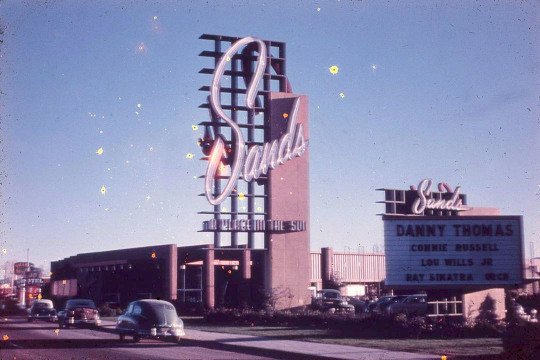
Sands Hotel & Casino '52-'96
Sands, December 1952
Kit Carson Club ('46-'50) Kit Carson Motel ('46-'63) La Lue nightclub ('50-'51)
'46: Kit Carson Club opened by H. Bynum, D. Anderson, G. Frisbee on US Hwy 91 outside of Las Vegas, adjacent to Kit Carson Motel. The club will later become LaRue nightclub, then the Garden Room of the Sands Hotel.
'50: Kit Carson Club reopened as LaRue nightclub opened by Billy Wilkerson, Nola Hahn, 12/23/50.
'51: LaRue closed by summer. Mack Kufferman buys LaRue, and hires architect Wayne McAllister to build around the existing club. Kuffman and partners apply for gaming license. The project is called Sands by 12/51.
Sands ('52-'96)
'52: Kufferman gaming license denied in Apr., sells to Jake Freedman (RG 4/9/52, RG 6/13/52). Partners running the Sands are B. Barron, E. Levinson (casino manager), S. Wyman, J. Entratter (showroom & restaurants). Hidden partners are believed to include J. Stacher, M. Lansky. Sands road sign designed by McAllister, built by YESCO. Sands opens 12/15/52 with 200 rooms in five buildings arranged in Y-shaped layout. The guest wings are named after race tracks: Arlington Park, Belmont Park, Haileah, Rockingham Park, Santa Anita. Three other wings of equal size were added circa ’53-54 (two were named Churchill Downs, Hollywood Park), another by ’58, and larger wing by ’60. The total room count in ’60 was 465.
'53: Frank Sinatra plays his first engagement at the Sands and becomes two percent owner in Oct; Carl Cohen joins the Sands as shareholder and casino manager in Oct.
'54: Sign modification: Second reader board added below the main board, Feb or earlier. Antonio Morelli joins the Sands as musical director for the Copa in Jul.
'55: Sands partners assume control of the Dunes in Sep. They sell the Dunes in four months later.
'58: Jake Freedman dies 1/19/58; Jack Entratter becomes Sands president.
'59: Sign modification: Attraction board attached to the sign, Feb or earlier. Baccarat begins at the Sands. Sands acquires the former Orinda Motel, property to the south, used for expansion of the Sands parking lot.
'60: Sinatra, Dean Martin, Sammy Davis Jr, Peter Lawford, and Joey Bishop (the "Rat Pack") are first billed together in the Copa in Jan-Feb. during the filming of Ocean's 11. Senator John F. Kennedy visits during the Democratic primary campaign.
'63: Opening of Aqueduct hotel wing (83 rm) in Apr. Julius Gabrielle, architect (RJ 4/28/63). Sinatra surrenders ownership 10/7/63.
'64: Sands acquires the former Kit Carson Motel; Belmont and Arlington buildings (base of the Y) moved southward to accommodate construction of a hotel tower.
'65: Second sign in Aug; tower completed late in the year and officially opened Jan. ’66. Martin Stern Jr, architect.
'67: Howard Hughes buys the Sands, 7/23/67. Sinatra leaves his Sands residency after confrontation with Cohen, 9/11/67.
'69: Dean Martin leaves Sands to join Riviera.
'71: Entratter dies, 3/8/71.
'73: Cohen leaves the Sands, Jan. '73.
'80: Inns of America buys the Sands from Hughes heirs Summa Corp in Oct.
'82: Third sign, new porte-cochère, marking the completion of remodeling effort including new Copa room, 1/15/82.
'83: Summa Corp reassumes control of the Sands, 4/5/83.
'88: Kirk Kerkorian buys the Sands in Jan. Kerkorian sells to Interface Group led by Sheldon Addison in Apr.
'90: Sands Expo and Convention Center opens.
'94: Remodeling of the casino.
'96: Sands closes 6/30/96. Tower demolished 11/26/96.
Photos of the Sands
Sources include David G. Schwartz. At the Sands: The Casino That Shaped Classic Las Vegas, Brought the Rat Pack Together, and Went Out With a Bang. December 1952 photo courtesy of Slidetreasurehunt.



Construction of the sign, 1952. The pylon sign pedestal was 56’ high, 21’ wide, with the S at 34’ tall. Design by Wayne McAllister, fabricated and installed by Young Electric Sign Co. Photo: YESCO Corporate Records (MS-00403), UNLV Special Collections & Archives.
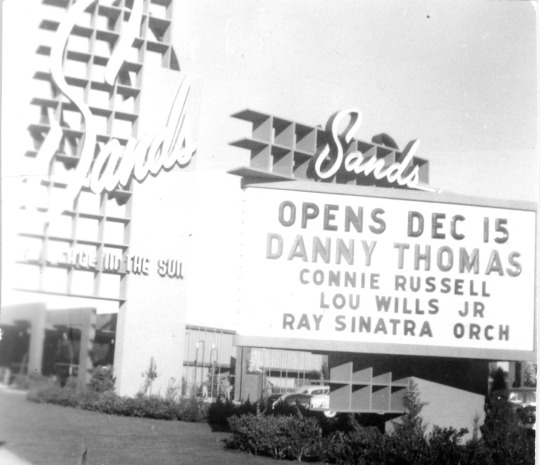
Opens Dec 15. Danny Thomas, Connie Rusell, Lou Wills Jr, Ray Sinatra Orchestra. Nevada State Museum, Las Vegas, 0007-0345.

Aerial view of Kit Carson Motel and the Sands, '62
55 notes
·
View notes
Text
Timeline
Alright, so, the difficulty I first ran into, is that I could not find an exact timeline for releases of Superman content, so through intensive googling, I managed to make a list of releases up to 1960.
1938 (Comics) Action Comics #1-8
1939 (Comics) Action Comics #9-19 | Superman #1-3
1940 (Comics) Action Comics #20-31 | Superman #4-7 (Radio) The Adventures of Superman "The Baby From Krypton" - "The Nitrate Shipment"
1941 (Comics) Action Comics #32-43 | Superman #7-13 | World's Finest Comics #1-4 (Radio) "Black Pearl of Osiris" - "The Pan-Am Highway" (Film) Fleischer Animated Series 1-2
1942 (Comics) Action Comics #44-55 | Superman #14-19 | World's Finest Comics #5-8 (Film) Fleischer Animated Series 3-13 (Radio) "The Mechanical Man" - The Mystery Ship" (Novel) Adventures of Superman by George Lowther
1943 (Comics) Action Comics #56-67 | Superman #20-25 | World's Finest Comics #9-12 (Film) Fleischer Animated Series 14-17 (Radio) ""The Tin Men" - "Stolen War Information"
1944 (Comics) Action Comics #56-79 | Superman #26-31 | World's Finest Comics #13-16 (Radio) "Lois and Jimmy Disappear" - "The Man in the Velvet Shoes"
1945 (Comics) Action Comics #80-91 | Superman #32-37 | More Fun Comics #101 | World's Finest Comics #17-20 (Radio) "The Mystery of the Sleeping Beauty" - "Looking for Kryptonite"
1946 (Comics) Action Comics #92-103 | Superman #38-43 | World's Finest Comics #21-24 (Radio) "The Talking Cat" - "The Phony Restaurant Racket" "Clan of the Fiery Cross"
1947 (Comics) Action Comics #104-115 | Superman #44-49 | World's Finest Comics #25-28 (Radio) "The Phony Inheritance Racket" - "Pennies for Plunder"
1948 (Comics) Action Comics #116-127 | Superman #50-55 | World's Finest Comics #29-32 (Film) Superman Serial (Columbia Pictures starring Kirk Alyn) (Radio) "Hunger Inc." - Superman's Secret"
1949 (Comics) Action Comics #128-139 | Superman #56-61 | Superboy #1-5 | World's Finest Comics #33-37 (Film) Keep Your School All-American (Radio) "The Return of the Octopus" - "Diamond of Death"
1950 (Comics) Action Comics #140-151 | Superman #62-67 | Superboy #6-11 | World's Finest Comics #38-49 (Film) Atom Man vs. Superman (Kirk Alyn)
1951 (Comics) Action Comics #152-163 | Superman #68-73 | Superboy #12-17 | World's Finest Comics #50- (Film) Superman and the Mole Men (George Reeves)
1952 (Comics) Action Comics #163-175 | Superman #74-79 | Superboy #18-23 | World's Finest Comics # (TV) Adventures of Superman (George Reeves) Season 1
1953 (Comics) Action Comics #176-187 | Superman #80-85 | Superboy #24-29 | World's Finest Comics # (Film) Adventures of Superman (George Reeves) Season 2
1954 (Comics) Action Comics #187-199 | Superman #86-93 | Superboy #30-37 | World's Finest Comics (Film) Stamp Day for Superman
1955 (Comics) Action Comics #200-211 | Superman #94-101 | Superboy #38-45 (Film) Adventures of Superman (George Reeves) Season 3
1956 (Comics) Action Comics #212-223 | Superman #102-109 | Superboy #46-53 (Film) Adventures of Superman (George Reeves) Season 4
1957 (Comics) Action Comics #224-235 | Superman #110-117 | Superboy #54-61 (Film) Adventures of Superman (George Reeves) Season 5
1958 (Comics) Action Comics #236-247 | Superman #118-125 | Superboy #62-69 (Film) Adventures of Superman (George Reeves) Season 6
1959 (Comics) Action Comics #248-259 | Superman #126-133 | Superboy #70-77 (Film) George Reeve's death.
1960 (Comics) Action Comics #260-271 | Superman #134-141 | Superboy #78-85 (Film) Superman (Mohammed Hussain)
However, upon joining the Superman subreddit Discord, I was kindly referred to this link on the Superman Supersite:
Which, heh, could have saved me some time. tbh.
3 notes
·
View notes
Text
SALUTE TO STAN LAUREL
November 23, 1965 on CBS

Directed by Seymour Berns
Produced by Henry Jaffe, Seymour Berns
Written by Hugh Wedlock Jr., Charles Isaacs, Alan Manings with Carl Reiner and Aaron Ruben
Cast (in order of appearance)
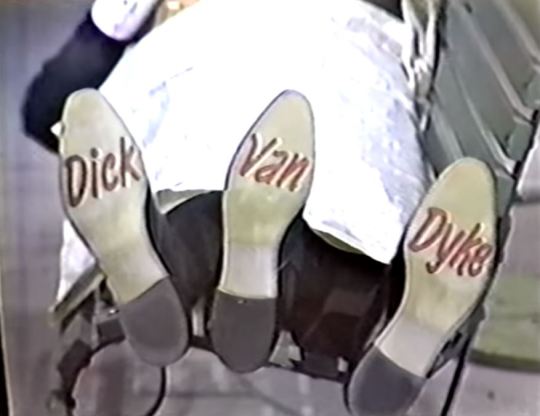
Dick Van Dyke (Host, Himself) was born Richard Wayne Van Dyke in West Plains, Missouri, in 1925. Although he’d had small roles beforehand, Van Dyke was launched to stardom in the 1960 Broadway musical Bye Bye Birdie, for which he won a Tony Award. He reprised his role in the 1963 film. He has starred in a number of other films throughout the years including Mary Poppins (1964) and Chitty Chitty Bang Bang (1968). From 1961 to 1966 he played TV writer Rob Petrie in “The Dick Van Dyke Show.” He also starred in “The New Dick Van Dyke Show” (1971-74), “Van Dyke & Company” (1976), on which Lucille Ball guest-starred. Van Dyke was often compared physically to Stan Laurel.
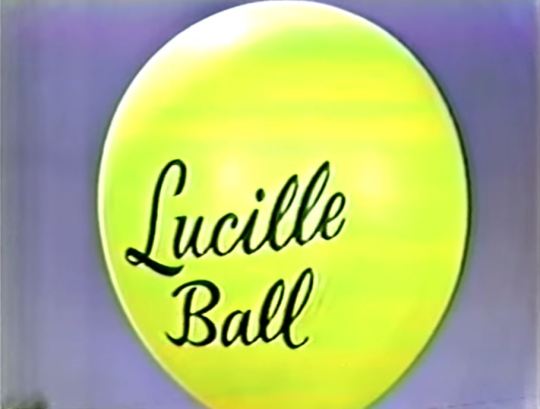

Lucille Ball (Woman in the Park) was born on August 6, 1911 in Jamestown, New York. She began her screen career in 1933 and was known in Hollywood as ‘Queen of the B’s’ due to her many appearances in ‘B’ movies. With Richard Denning, she starred in a radio program titled “My Favorite Husband” which eventually led to the creation of “I Love Lucy,” a television situation comedy in which she co-starred with her real-life husband, Latin bandleader Desi Arnaz. The program was phenomenally successful, allowing the couple to purchase what was once RKO Studios, re-naming it Desilu. When the show ended in 1960 (in an hour-long format known as “The Lucy-Desi Comedy Hour”) so did Lucy and Desi’s marriage. In 1962, hoping to keep Desilu financially solvent, Lucy returned to the sitcom format with “The Lucy Show,” which lasted six seasons. She followed that with a similar sitcom “Here’s Lucy” co-starring with her real-life children, Lucie and Desi Jr., as well as Gale Gordon, who had joined the cast of “The Lucy Show” during season two. Before her death in 1989, Lucy made one more attempt at a sitcom with “Life With Lucy,” also with Gordon, which was not a success and was canceled after just 13 episodes.
Ball has no spoken dialogue in her sketch.
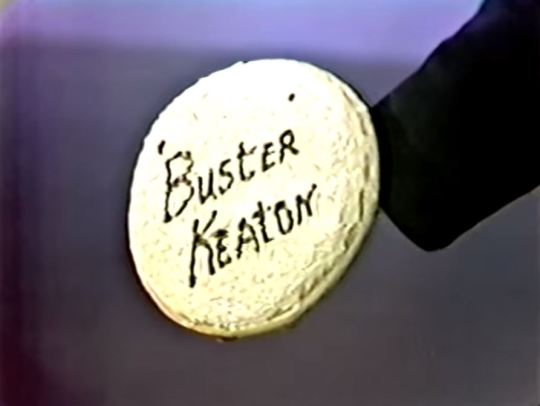
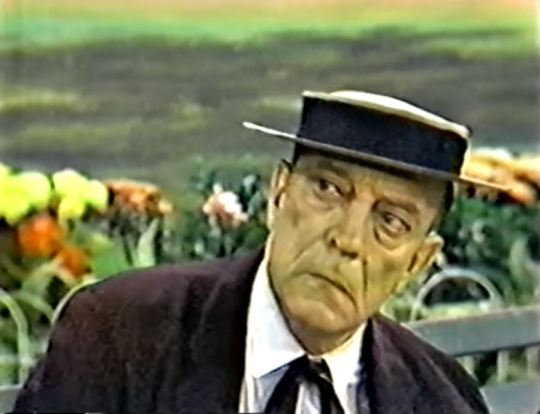
Buster Keaton (Painter in the Park) was born in 1895 to parents who were vaudevillians. His legendary film career began in 1917. He became a star known for his slapstick comedy, pork pie hat, slapshoes, and deadpan expression. In 1960 he was given an honorary Oscar. Lucille Ball worked with Keaton on the 1946 film Easy To Wed. He died in February 1966, just two months after this special aired.
Keaton has no spoken dialogue in his sketch.
Harvey Korman (Policeman in the Park) is best known as part of “The Carol Burnett Show” (1967-77). He made five appearance on “The Lucy Show” as various characters. In 1977 he had his own show on ABC which lasted just one season. At the time of this episode he was a regular on “The Danny Kaye Show” (1963-67) which aired Friday nights on CBS. He died in May 2008.
Korman has no spoken dialogue in his sketch.
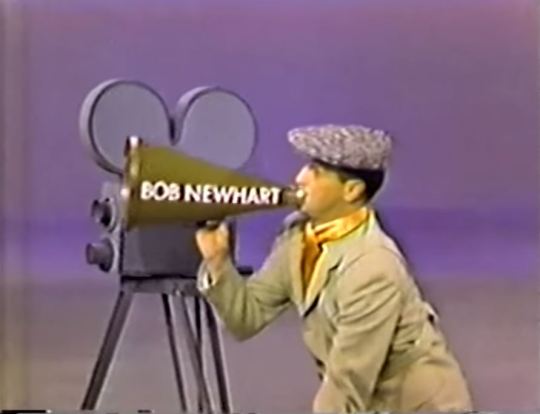
Bob Newhart (Himself / Uncle Freddy) is a stand-up comic with a deadpan delivery who headed two eponymous television sitcoms: “The Bob Newhart Show” (1972-78) and “Newhart” (1982-90).
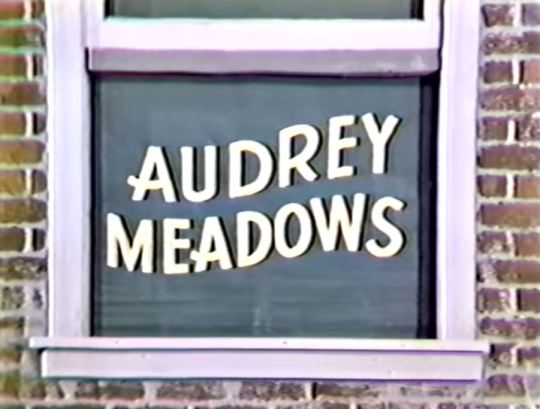
Audrey Meadows (Pearl) is best remembered as Alice Kramden on “The Honeymooners” (1955-56), a role that won her an Emmy in 1955, against Vivian Vance as Ethel Mertz on “I Love Lucy.” She also played Lucy's sister on an episode of “Life With Lucy” (1986). Meadows died in 1996 at age 73.
Meadows has no spoken dialogue in her sketch “The Perils of Pearl.”
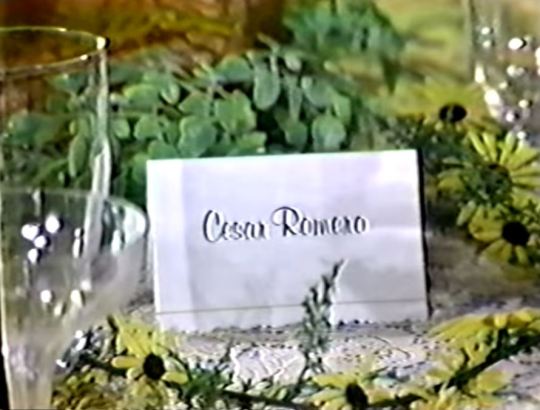
Cesar Romero (Rod, Leading Man) was born in 1907 in New York City to Cuban parents. Despite earning more than 200 screen credits, Romero is perhaps best remembered for playing the Joker on TV’s “Batman” (1966-68) and in a Batman film in 1966. He played Ricky Ricardo’s buddy Carlos when “Lucy Takes a Cruise to Havana” (LDCH 1957), the very first hour-long episode of “I Love Lucy” set in Cuba in 1940, as well as Lucy Carmichael's date in “A Date for Lucy” (TLS S1;E19). He died on New Year’s Day 1994 at age 86.

Tina Louise (Wilma, Leading Lady) is best known as 'the movie star' Ginger Grant on “Gilligan's Island” (1964-67). This is only appearance with Lucille Ball.
Louise has no spoken dialogue in her sketch.
Leonid Kinskey (Silent Movie Director) was born in Russia in 1903. He played a variety of Russian and middle-European characters. One of the few to share film credits with Stan Laurel, they were both seen in Hollywood Party in 1936. He died in 1998 at age 95.
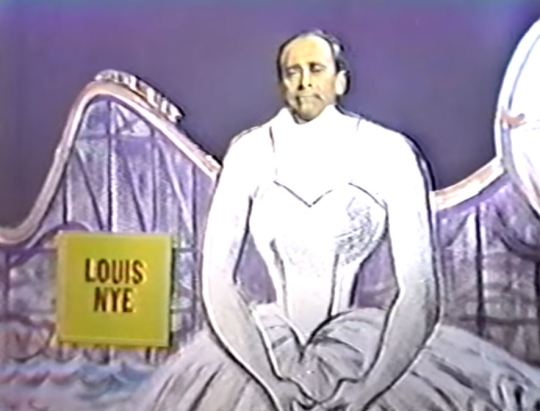
Louis Nye (Mood Music Musician) was a character actor skilled in accents and voices. He appeared with Lucille Ball in the films The Facts of Life (1960) and A Guide for the Married Man (1967). He died in 2005 at age 92.
Fred Gwynne (Herman Munster) was the star of two iconic television series: “Car 54 Where Are You” (1961-63) and “The Munsters” (1964-66), the role he reprises here. This is his only time working on the same show as Lucille Ball (although the two TV icons share no scenes together). He died in 1993 at age 66.
Gwynne has no dialogue in the sketch.
Danny Kaye (Himself) was born David Kaminsky in 1911 and left school at the age of 13 to work in the Borscht Belt of Jewish resorts in the Catskill Mountains. It was there he learned the basics of show biz. In 1939, he made his Broadway debut in Straw Hat Revue, but it was the stage production of the musical Lady in the Dark in 1940 that brought him acclaim and notice from agents. Also in 1940, he married Sylvia Fine, who went on to manage his career. She helped create the routines and gags, and wrote most of the songs that he performed. Danny could sing and dance like many others, but his specialty was reciting tongue-twisting songs and monologues. In 1964 he appeared on “The Lucy Show” as himself and Lucy appeared on his special in return. He died in 1987.

Phil Silvers (Himself) was born Philip Silversmith in 1911 (the same year as Lucille Ball). He started entertaining at age 11. He made his Broadway debut in 1939. In 1952 he won a Tony Award in the Broadway musical Top Banana in which he played a TV star modeled on Milton Berle. His feature film debut came in 1940. Silvers became a household name in 1955 when he starred as Sergeant Ernest G. Bilko. In 1963, Ball and Silvers performed the classic ‘Slowly I Turn’ sketch for “CBS Opening Night.” In December 1966 Silver guest-starred in “Lucy and the Efficiency Expert” (TLS S5;E13). A year later Ball and Silvers both had bit parts in the film A Guide for the Married Man (1967). He died at the age of 74.
Bern Hoffman (Pop / Street Bully / Cop) was a burly character actor seen with Lucille Ball on the first season of “The Lucy Show” and in the film The Facts of Life (1960). He was seen on Broadway in the original casts of the musicals Guys and Dolls (1950) as Joey Biltmore and Li'L Abner (1956) as Earthquake McGoon, a role he recreated in the 1959 film version.
None of Hoffman's characters speak.
Mary Foran (Mom / Tango Dancer) was a heavyset character actor usually cast for her size. She appeared as one of the women at the health club in “Lucy and the Countess Lose Weight” (TLS S3;E21) earlier in 1965.
Foran does not have any dialogue.
Gregory Peck (Himself) was one of the most popular film stars from the 1940s to the 1960s. Peck received five Academy Award nominations winning for his performance as Atticus Finch in the 1962 drama film To Kill a Mockingbird. Although Peck and Lucille Ball never appeared together professionally, his name was mentioned several times on “Lucy” sitcoms. He also never worked with Stan Laurel. Peck died in 2003 at age 87.
Archival Footage
Stan Laurel (Archive Footage) was born as Arthur Stanley Jefferson in England in 1890. Laurel began his career in music hall, where he developed a number of his standard comic devices: the bowler hat, the deep comic gravity, and the nonsensical understatement. He began his film career in 1917 and made his final appearance in 1951. From 1928 onward, he appeared exclusively with Oliver Hardy (1892-57). Known simply as Laurel and Hardy, the pair became one of the most recognizable comic duos in history. Stan Laurel passed away in February 1965, eight months prior to this tribute show. He was 74 years old.
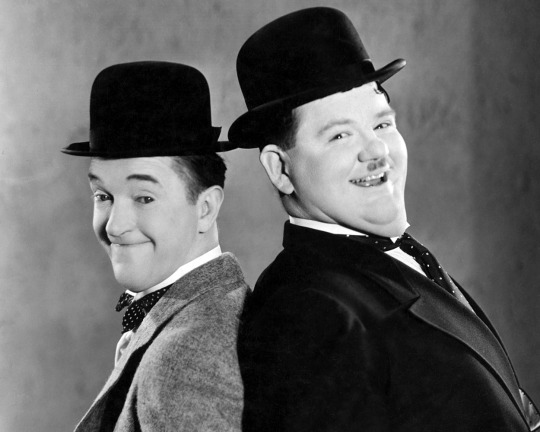
Oliver Hardy (archive footage) was born Norvell Hardy in Georgia USA in 1892. He appeared with his comedy partner Stan Laurel in 107 short films, feature films, and cameo roles. He was credited with his first film, Outwitting Dad, in 1914. In some of his early works, he was billed as "Babe Hardy". He died in 1957 at age 65.
Dorothy Coburn (Nurse in “The Finishing Touch” Archive Footage) was ideally cast as a perennial foil for Stan Laurel and Oliver Hardy in films like The Second 100 Years (1927) where Stan inadvertently covers her bottom with white paint; Putting Pants on Philip (1927) in which she is being chased by an over-amorous, kilt-wearing Stan Laurel around town; and as a dentist's nurse in Leave 'Em Laughing (1928). She died in 1978 at age 72.
Edgar Kennedy (Cop in “The Finishing Touch” Archive Footage) was seen with Laurel and Hardy in more than a dozen films. He was also seen in three RKO films with Lucille Ball in the early 1930s. He died in 1948 and his final film was released posthumously.
Betty Grable (Pat Lambert in Footlight Serenade Archive Footage) was a starlet who did three films with Lucille Ball from 1933 to 1936. In 1958 she appeared with her husband bandleader Harry James as themselves on an episode of “The Lucy-Desi Comedy Hour.” Footlight Serenade (1942) was also supposed to feature Lucille Ball, but she refused to be loaned out to Fox to play a secondary role.
Stan Salute Trivia

The tribute was not well-received by critics, who opined that the program felt less like a celebration of Laurel's career than a promo for the new fall shows; the same critics were, however, in general agreement that Van Dyke's devotion was palpable and heartfelt. Consequently Laurel and Hardy biographers tend to regard it as well-intentioned, but ultimately inconsequential. Wrapping up the season in April 1966, TV Chronicle's Neil Compton would dismiss the special’
"Not much of a tribute to the late comedian (who appeared briefly in a number of film clips brutally hacked out of their original context), and did not enhance the reputations of participants such as Dick Van Dyke, Lucille Ball, or Phil Silvers."

Dick Van Dyke (who was also one of the producers) reportedly complained that his vision for the Salute had itself been hacked to pieces by network corporate types. Van Dyke had delivered the eulogy and Stan Laurel's funeral. An appearance by Fred Gwynne in full Herman Munster regalia clearly had more to do with CBS (home of “The Munsters”) than with Laurel. A lengthy biography of Phil Silvers in the show's second half also has little to do with Laurel. On the whole, the special is a tribute to both Laurel AND Hardy, who passed away eight years earlier.
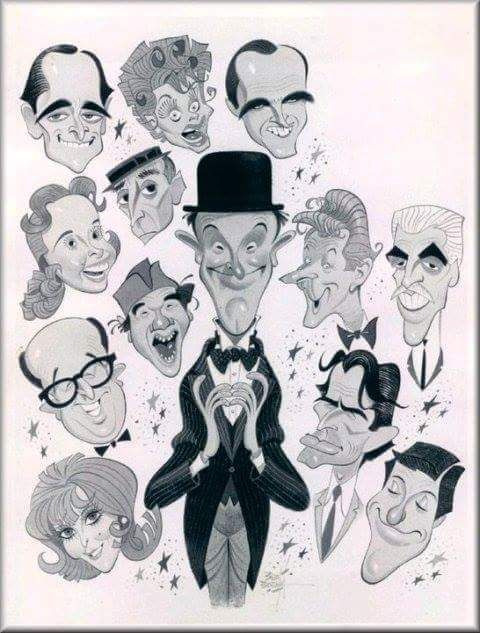
The Salute aired opposite new episodes of “McHale's Navy” and “F-Troop” on ABC and “Dr. Kildare” on NBC. It was preceded on CBS by “Rawhide” (starring Clint Eastwood) and followed by “Petticoat Junction.”
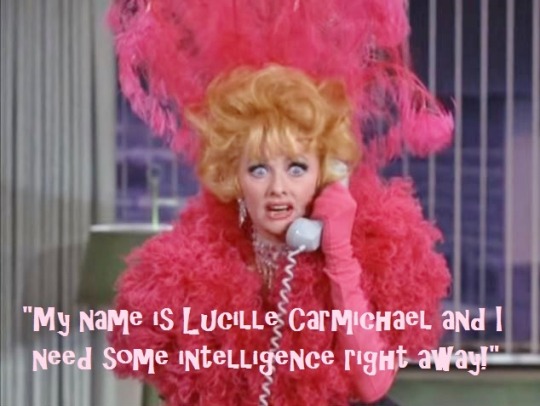
The day before (Monday, November 22), “Lucy and the Undercover Agent” (TLS S4;E10) was aired for the first time. In the episode, Mrs. Carmichael goes undercover as Carol Channing to break into a government installation!
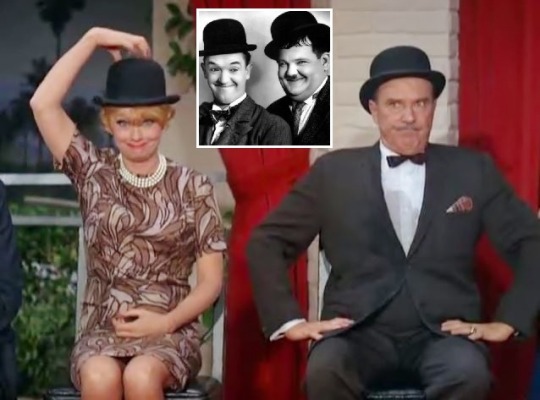
One year after this special aired, Lucy Carmichael and Mr. Mooney were put under hypnosis by Miss Pat, “the hip hypnotist” (a nightclub entertainer). Their hypnotic suggestion was to imitate Laurel and Hardy. Lucy, naturally, was Stan Laurel.
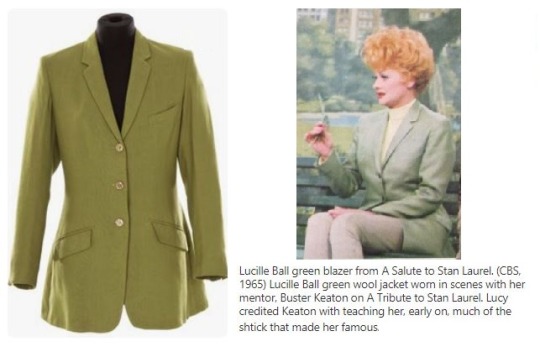
The underscoring of the Salute makes liberal use of “Dance of the Cuckoos” which was Laurel and Hardy's theme music. It was written by Marvin Hartley as the 'hour chime' for a radio station. It was first heard during a Laurel and Hardy film in 1930.
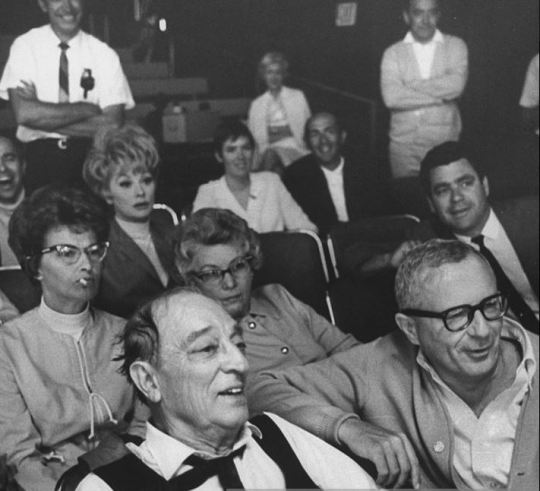
This was the last comedy performance of Buster Keaton, who had been diagnosed as terminally ill and would die a few months later. Lucy and Keaton were there own mutual admiration society, Lucy considering him her mentor and Keaton championing Ball's talents, even before her TV fame. In the above photo, Keaton and Ball watch the dailies from their sketch on the Salute.
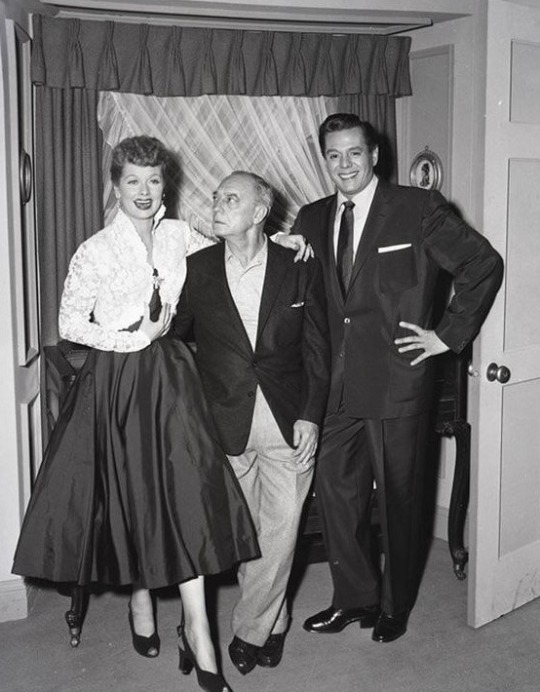
Although Buster Keaton never guest-starred on a “Lucy” sitcom, he did visit the set of “I Love Lucy” to see his now successful protege.

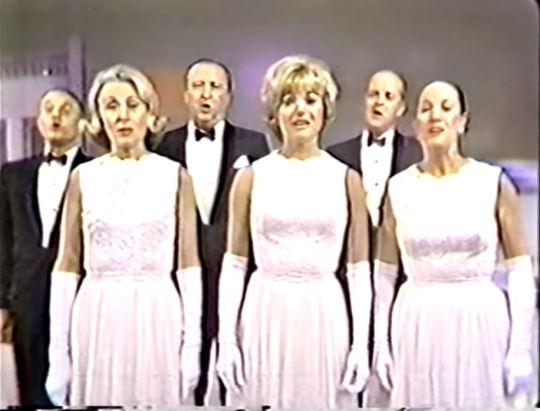
The Salute begins with a production number called “Stanley” featuring singer / dancers dressed as Laurel and Hardy inter-cut with film footage of the pair and the opening credits.
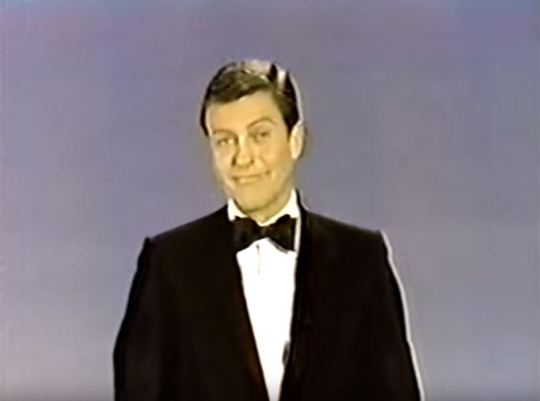
After the first commercial Dick Van Dyke introduces the show. He says that he never got to meet Oliver Hardy, but did know Stan Laurel. Film excerpts from “Wrong Again” (1929), which was re-released by MGM as “Laurel and Hardy's Laughing 20s”, a compilation of Laurel and Hardy shorts.
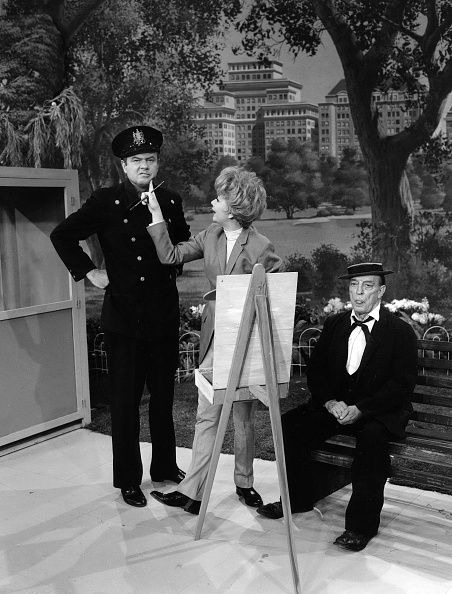
Lucille Ball and Buster Keaton perform a silent sketch set on a park bench. Harvey Korman plays a cop. The sketch is without words, but includes background music, exaggerated sound effects, and the ubiquitous laugh track.
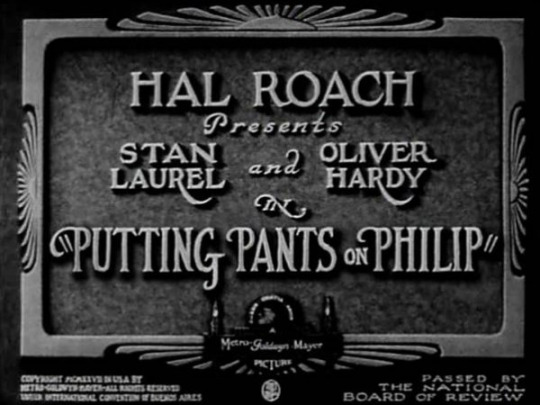
After a brief clip from the Laurel and Hardy short “Putting Pants on Philip” (1927), Dick Van Dyke gives a lecture on comedy rooted in observing physical pain in others. He notes how comedy has changed, all the while having a series of funny accidents. This “comedy lecture” was specially written by Carl Reiner and Aaron Ruben.
Blooper Alert! When Van Dyke gets a waste paper basket stuck on his foot, he kicks it offstage. It apparently collides with someone off-camera, which makes Van Dyke laugh and apologize. Just before this happened, the boom microphone dips down into the frame.
The 'lecture' ends with Van Dyke tripping over a footstool on his way out, something he did in the opening credits of his show.

Bob Newhart talks about his research on Laurel and Hardy. He does his impression of a stereotypical kiddie show host named Uncle Freddy. Such TV kiddie shows were often the outlet for showing Laurel and Hardy shorts.
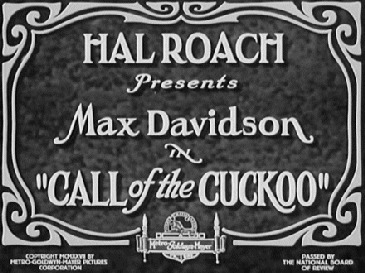
After a clip from “Call of the Cuckoo” (1927), an audience at an old time cinema sings about seeing ‘The Perils of Pearl’, the type of serial melodrama that typically played alongside a comedy feature by Laurel and Hardy.

Audrey Meadows plays Pearl, in a variety of her 'perils': As a women about to be bisected by a mill saw, a harem dancer pursued by an over-amorous Calif, a cowgirl burned at the stake by Indians, and a woman sitting atop a giant time bomb.
Movie-Goers: “Will they blow up little Pearl? Is her life at stake? To be continued [the look into the camera] ... after station break!”

After the commercial break, the movie-goers are still looking at the camera. They look back at the movie screen where Pearl is still atop the bomb.
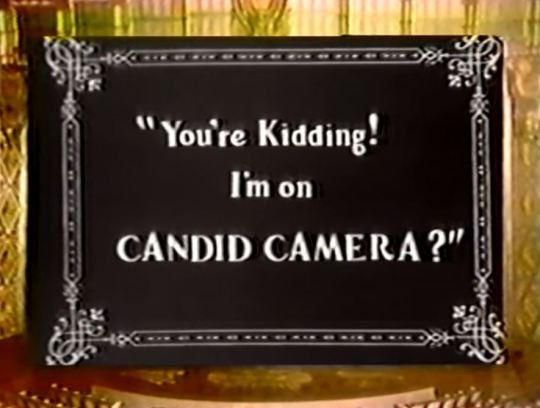
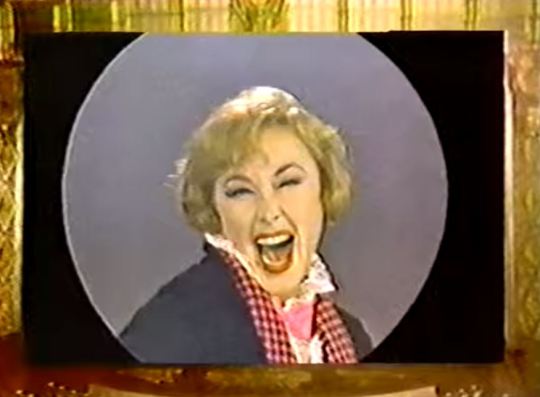
Pearl laughs and her hat falls off. The matinee audience is suddenly onstage in a full out dance number!
Dick Van Dyke introduces a comedy sketch about the filming of a silent movie.
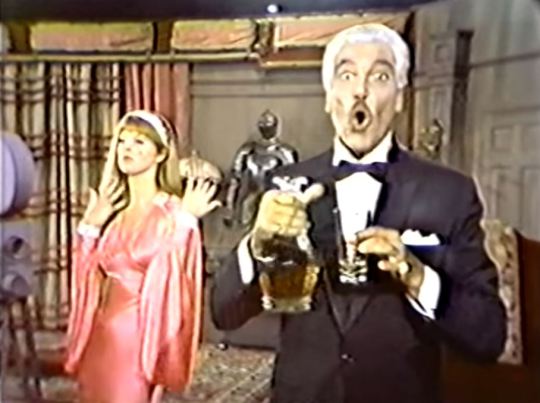
It stars Cesar Romero as The Leading Man, Tina Louise as The Leading Lady, Leonid Kinsky as The Director, and Louis Nye as The Mood Music Musician (aka violinist).
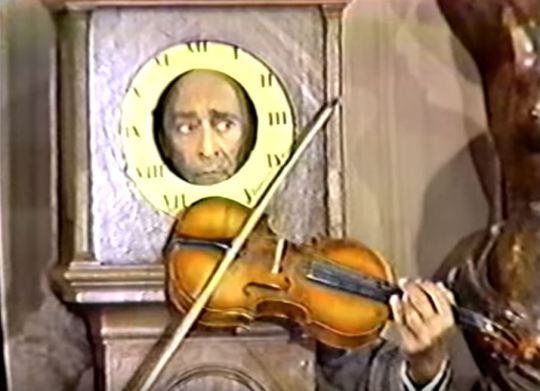
The comedy comes from Nye trying to stay out of the pantomimed action while providing the mood music to help the actors emote. After destroying several violins, Nye himself falls out the window.
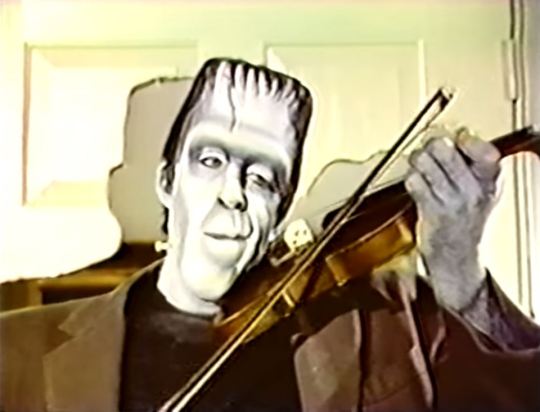
Crashing through the door comes his replacement, Herman Munster (Fred Gwynne) playing the fiddle! This is the first time a 1865 TV audience has seen Gwynne in color, although his green complexion would be on display in a 1966 Munsters movie.
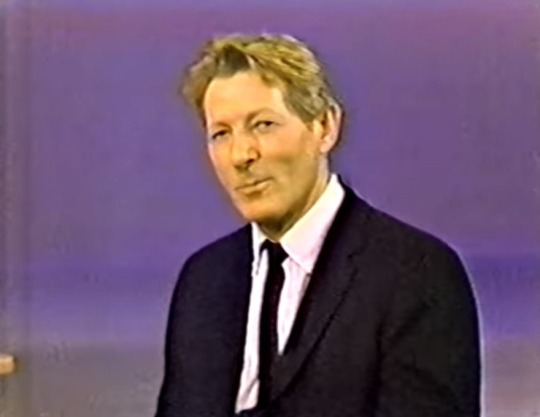
Danny Kaye is sitting beside Stan Laurel's honorary Oscar, which Kaye accepted for Laurel in 1961. A clip of “The Finishing Touch” (1928) shows Laurel installing a window.
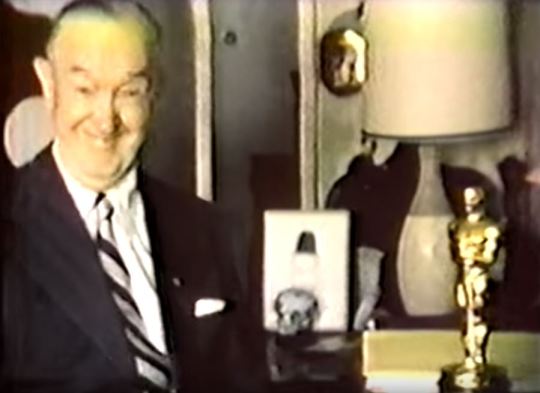
Color (but silent) footage shows Laurel polishing his Oscar from his home in 1961.
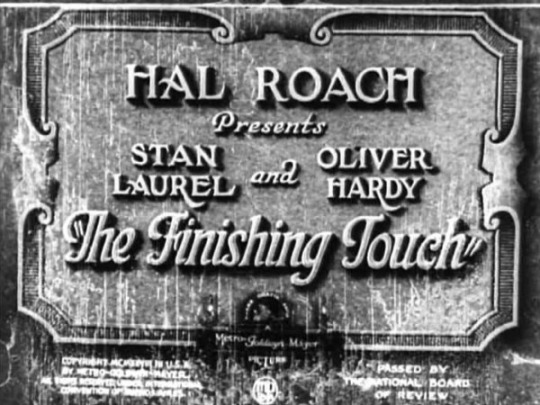
Sitting among a stack of film reels, Dick Van Dyke introduces another clip from “The Finishing Touch” (1928) in which Laurel and Hardy are renovating a house.
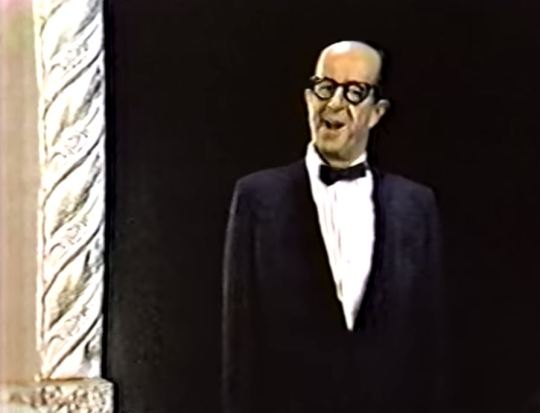
Phil Silvers compares Laurel's youth as “a little man” to his own life story. A sketch shows a bespectacled Silvers in a baby bonnet and crib with his mother and father beside him. His teen years (in a page boy wig) feature his cracking voice singing “Shine On Harvest Moon.”
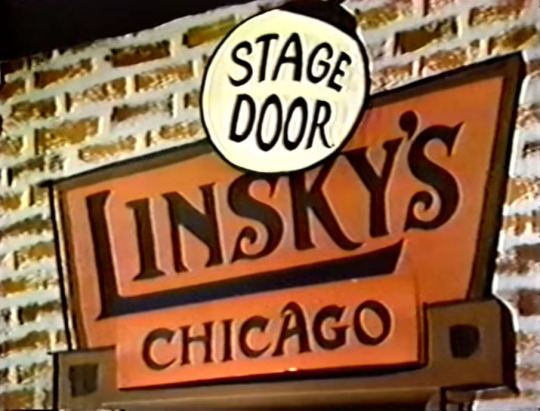
The mini-biography tracks Silvers' career from street performer to vaudeville.
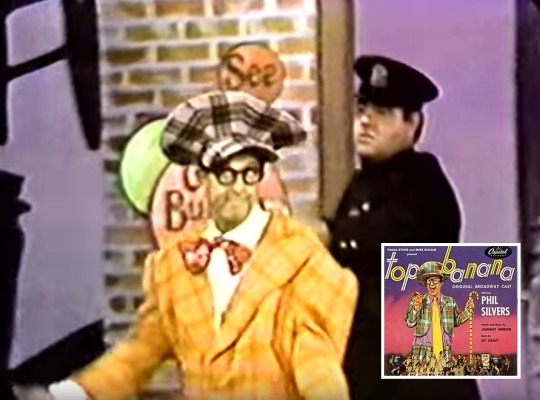
In Burlesque, he plays Linksy's theatre (a pun on the real-life Minsky's Burlesque) wearing the same huge plaid cap that he wore onstage and screen in the musical Top Banana ten years earlier.

Actual footage from his big break in movies shows Silvers and Betty Grable in Footlight Serenade (1942). Silvers finally brings his story back to Stan Laurel, but not without a few quick clips of him in “Sergeant Bilko”!
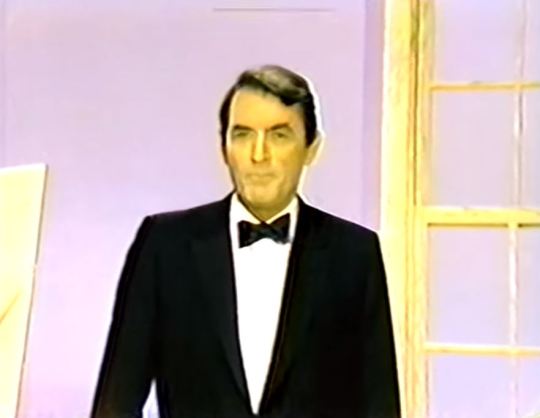
Gregory Peck closes the program by thanking everyone and giving a last pitch for the new MGM film compilation of Laurel and Hardy's shorts.
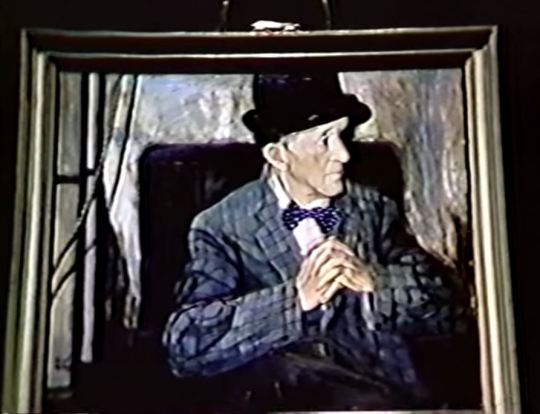
The singers and dancers who opened the show return for a final chorus of “Stanley.” The number ends on a shot of a painting of Stan Laurel. This same painting inspired the creation of the show.
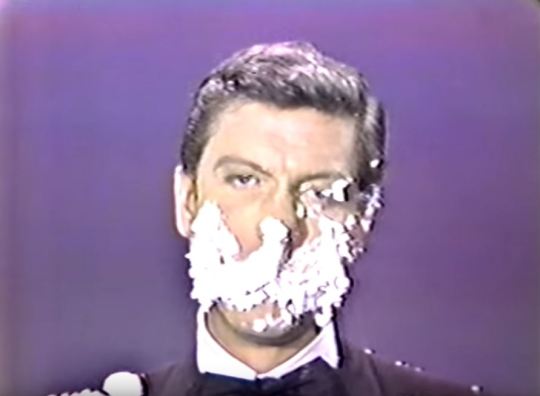
Dick Van Dyke returns for yet another pitch for the MGM film compilation “Laurel and Hardy's Laughing 20s”. Van Dyke gets a face full of cake at the very end, inter-cut with Oliver Hardy slipping on a banana peel while carrying a huge cake excerpted from 1928's “From Soup To Nuts.”
This Date in Lucy History – November 23
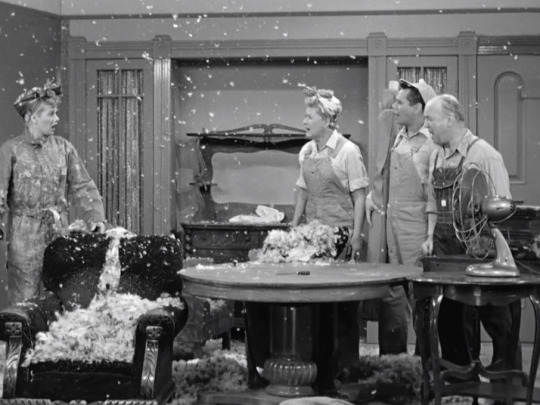
"Redecorating the Mertzes' Apartment" (ILL S3;E8) – November 23, 1953
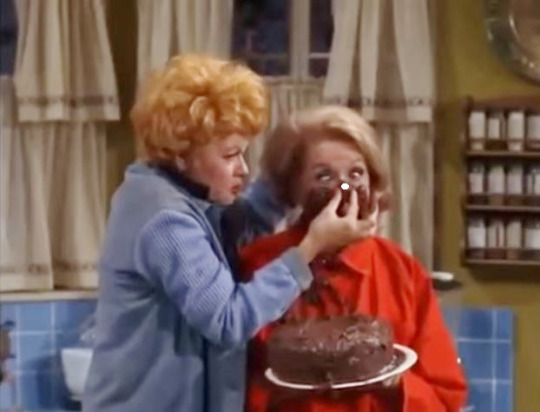
"Lucy's Contact Lenses" (TLS S3;E10) – November 23, 1964
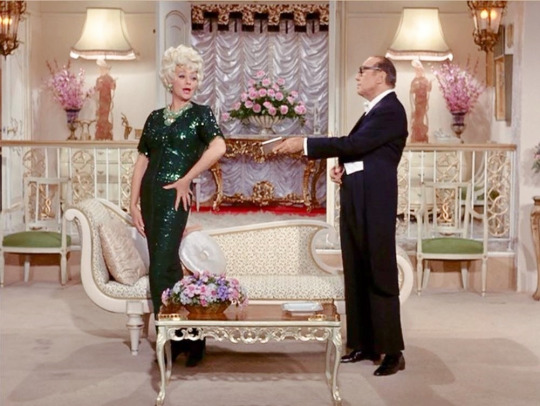
“Lucy and Jack Benny's Biography” (HL S3;E11) – November 23, 1970
#A Salute To Stan Laurel#Lucille Ball#Stan Laurel#Oliver Hardy#Laurel and Hardy#Buster Keaton#Harvey Korman#Dick Van Dyke#Carl Reiner#comedy#slapstick#silent movies#Hal Roach#Audrey Meadows#Tina Louise#Cesar Romero#Louis Nye#Leonid Kinskey#Bob Newhart#Danny Kaye#Phil Silvers#Gregory Peck#Bern Hoffman#Mary Foran#Dorothy Coburn#Betty Grable#Edgar Kennedy#Seymour Berns#CBS#TV
5 notes
·
View notes
Link
via Politics – FiveThirtyEight
Pretend I’m the owner of a polling company that surveys political races. I prominently advertise my results: According to a Walt Hickey Polling Inc. survey of 600 likely voters, John Doe is beating Jane Doe 58 percent to 40 percent — John Doe will likely win the election. (Let’s say it’s a race for the U.S. Senate.)
But then you keep reading and you notice that the sample on which my poll is based consists of 400 men and 200 women. You can’t really tell whether I’m adjusting the numbers, and if so, how. Would you trust that number? Unless there’s some state I don’t know about where men outnumber women 2-to-1, you shouldn’t.
So why aren’t we more skeptical of movie ratings that do the same thing?
It’s a worthwhile question, and lately it’s made it pretty hard for us to take the ratings provided on IMDb, the largest and most popular movie site on the internet, at face value. The Academy Awards rightly get criticized for reflecting the preferences of a small, unrepresentative sample of the population, but online ratings have the same problem. Even the vaunted IMDb Top 250 — nominally the best-liked films ever — is worth taking with 250 grains of salt. Women accounted for 52 percent of moviegoers in the U.S. and Canada in 2016, according to the most recent annual study by the Motion Picture Association of America. But on the internet, and on ratings sites, they’re a much smaller percentage.
“If you see any number that is a rating number or a number with a percentage sign, it may be compelling or meaningful and it may not be,” said Gary Langer, the president of Langer Research Associates, the polling firm that has long conducted surveys for ABC News. “And what we need to do rather than be seduced by the number is to subject it to meaningful inquiry as to how it was obtained.”
OK, but how skeptical should we be? To figure that out, I wanted to see how strong the male skew of raters is on IMDb and how big an effect that skew has on movies’ scores.
We’ll start with every film that’s eligible for IMDb’s Top 250 list. A film needs 25,000 ratings from regular IMDb voters to qualify for the list. As of Feb. 14, that was 4,377 titles. Of those movies, only 97 had more ratings from women than men. The other 4,280 films were mostly rated by men, and it wasn’t even close for all but a few films. In 3,942 cases (90 percent of all eligible films), the men outnumbered the women by at least 2-to-1. In 2,212 cases (51 percent), men outnumbered women more than 5-to-1. And in 513 cases (12 percent), the men outnumbered the women by at least 10-to-1.
Looking strictly at IMDb’s weighted average — IMDb adjusts the raw ratings it gets “in order to eliminate and reduce attempts at vote stuffing,” but it does not disclose how — the male skew of raters has a pretty significant effect. In 17 percent of cases, the weighted average of the male and female voters was equal, and in another 26 percent of cases, the votes of the men and women were within 0.1 points of one another. But when there was bigger disagreement — i.e. men and women rated a movie differently by 0.2 points or more, on average — the overall score overwhelmingly broke closer to the men’s rating than the women’s rating. The score was closer to the men’s rating more than 48 percent of the time and closer to the women’s rating less than 9 percent of the time, meaning that when there was disagreement, the male preference won out about 85 percent of the time.
That male skew of raters is also apparent in the 250 movies that make IMDb’s top list, which we pulled on Feb. 16:
So, what’s the issue here? If IMDb is content with its ratings being intended almost solely for men, then there isn’t one. (We reached out to IMDb for comment and for more information on how the site adjusts its ratings, but we received no response. So we don’t know, for example, if IMDb is already doing something to the data that accounts for the gender disparity in raters.) But if IMDb seeks to reflect the opinions of the actual movie-going population, the situation is grave.
Can we fix that? Langer is skeptical. Mainly, besides how simple it is for a dedicated individual or group to “manufacture” results, online data from a self-selected group of people is so inherently dubious that any reweighting of that data is also inherently dubious. You can’t just adjust troublesome data to make it reflect the world, he said.
“The notion that you can take bad data and weight it to be OK is … hazardous to your health,” Langer cautioned.
That said, since the scores of the most popular movie site on the internet are already being calculated based on an entirely self-selected sample, would it destroy the IMDb Top 250 to try to mimic actual movie audiences more? I don’t really think so. As a thought experiment, I used everything we know about IMDb’s rating adjustments — which is far from the full picture — and ran them on the ratings of the 4,377 eligible films after I adjusted the raw ratings to weight men’s and women’s views equally.
We can’t do an adjustment that allows us to perfectly replicate the top 250 — again, we don’t know what’s in the black box, so we can’t re-create it — but to approximate it, I excluded any film that didn’t either a) make the IMDb top 1,000 movies list or b) have a rating from the site’s top 1,000 users within 0.87 points1 of the rating from its users overall. This allows us to sidestep films that would have made the top 250 through vote-stuffing.
My main point is that overall, the naive reweighting didn’t destroy the general look of the 250, and if anything, it elevated films that may have been overlooked because one gender is vastly outnumbered.2
What if IMDb adjusted ratings toward gender parity?
Estimated highest-ranking films on IMDb if the men’s and women’s ratings were weighted toward 50-50 vs. IMDb’s actual rank as of Feb. 16, 2018
Rankings Year▲▼ Film▲▼ Actual▲▼ Women only▲▼ Men only▲▼ Gender- weighted▲▼ 1994 The Shawshank Redemption 1 1 1 1 1972 The Godfather 2 10 2 2 2008 The Dark Knight 4 3 3 3 2003 The Lord of the Rings: The Return of the King 8 2 4 4 1993 Schindler’s List 6 6 11 5 1999 Fight Club 10 5 8 6 2001 The Lord of the Rings: The Fellowship of the Ring 11 7 10 7 1957 12 Angry Men 5 27 7 8 1974 The Godfather: Part II 3 22 5 9 2010 Inception 14 8 6 10 1994 Forrest Gump 12 9 13 11 2002 The Lord of the Rings: The Two Towers 15 11 14 12 1994 The Lion King 47 4 29 13 1994 Pulp Fiction 7 15 9 14 2014 Interstellar 30 25 15 15 1999 The Green Mile 32 12 28 16 1975 One Flew Over the Cuckoo’s Nest 16 24 19 17 1966 The Good, the Bad and the Ugly 9 115 12 18 2006 The Prestige 48 26 16 19 1998 American History X 31 17 27 20 2012 The Dark Knight Rises 65 23 22 21 1997 Life Is Beautiful 25 16 41 22 1980 Star Wars: Episode V – The Empire Strikes Back 13 41 17 23 1994 Leon: The Professional 27 21 37 24 2002 City of God 21 64 20 25 1995 Se7en 22 28 23 26 2001 Spirited Away 28 13 56 27 1991 The Silence of the Lambs 23 20 33 28 2006 The Departed 40 35 26 29 1990 Goodfellas 17 71 18 30 2011 The Intouchables 37 19 52 31 2014 Whiplash 45 54 30 32 2000 Gladiator 46 44 24 33 2012 Django Unchained 60 29 31 34 2002 The Pianist 39 31 53 35 1946 It’s a Wonderful Life 24 56 51 36 1960 Psycho 34 55 40 37 1977 Star Wars: Episode IV – A New Hope 20 48 32 38 2009 Inglourious Basterds 97 32 43 39 1998 Saving Private Ryan 29 70 25 40 1995 The Usual Suspects 26 58 36 41 1999 The Matrix 18 62 21 42 2000 Memento 49 57 34 43 1942 Casablanca 36 73 42 44 1999 American Beauty 63 51 35 45 1985 Back to the Future 44 49 46 46 2001 A Beautiful Mind 144 34 68 47 1954 Rear Window 43 80 60 48 2000 Requiem for a Dream 80 50 49 49 2011 Harry Potter and the Deathly Hallows: Part 2 218 14 126 50 2006 The Lives of Others 58 86 78 51 2010 Shutter Island 177 39 59 52 2008 WALL-E 62 42 62 53 2004 Eternal Sunshine of the Spotless Mind 87 38 66 54 1980 The Shining 61 61 47 55 1997 Good Will Hunting 102 60 48 56 1971 A Clockwork Orange 84 79 50 57 2001 Amelie 82 30 90 58 1954 Seven Samurai 19 336 39 59 1983 Star Wars: Episode VI – Return of the Jedi 76 87 63 60 1992 Reservoir Dogs 77 94 64 61 2017 Coco 51 209 166 62 1988 Cinema Paradiso 54 165 97 63 1979 Apocalypse Now 50 219 38 64 1940 The Great Dictator 53 262 101 65 1950 Sunset Boulevard 55 190 108 66 1931 City Lights 35 294 92 67 1997 Princess Mononoke 64 118 100 68 2015 Room 143 82 139 69 2003 Pirates of the Caribbean: The Curse of the Black Pearl > 250 36 113 70 2004 Howl’s Moving Castle 137 43 216 71 1962 To Kill a Mockingbird 89 102 135 72 2009 Up 115 37 117 73 2014 Gone Girl 179 81 70 74 2010 Toy Story 3 98 66 82 75 1936 Modern Times 38 248 96 76 1988 Grave of the Fireflies 57 159 133 77 2006 Pan’s Labyrinth 130 74 91 78 2016 Hacksaw Ridge 175 161 124 79 1968 2001: A Space Odyssey 91 195 54 80 2007 Into the Wild 181 84 95 81 1958 Vertigo 72 154 87 82 2015 Inside Out 140 78 107 83 2005 Batman Begins 116 106 58 84 1975 Monty Python and the Holy Grail 103 123 104 85 2009 3 Idiots 93 203 93 86 2003 Oldeuboi 67 171 73 87 1964 Dr. Strangelove or: How I Learned to Stop Worrying and Love the Bomb 56 236 57 88 1991 Terminator 2 42 178 44 89 1959 North by Northwest 74 205 99 90 1968 Once Upon a Time in the West 33 447 55 91 1981 Raiders of the Lost Ark 41 131 65 92 1995 Toy Story 94 85 80 93 1952 Singin’ in the Rain 90 110 170 94 2016 La La Land 207 122 86 95 1979 Alien 52 151 67 96 1941 Citizen Kane 71 188 74 97 2002 Catch Me if You Can 219 97 81 98 1983 Scarface 105 181 69 99 1976 Taxi Driver 88 164 71 100 2014 The Grand Budapest Hotel 194 65 128 101 1987 Full Metal Jacket 92 177 83 102 2010 How to Train Your Dragon 176 47 165 103 1984 Amadeus 83 128 121 104 2007 There Will Be Blood 165 212 72 105 2012 The Avengers > 250 52 144 106 1984 Once Upon a Time in America 69 337 88 107 2013 The Wolf of Wall Street 150 158 45 108 2005 V for Vendetta 151 76 112 109 1939 Gone With the Wind 157 46 279 110 2003 Kill Bill: Vol. 1 174 89 114 111 1995 Braveheart 75 141 61 112 2003 Finding Nemo 166 53 151 113 1999 The Sixth Sense 160 75 116 114 2011 The Help 241 33 245 115 2015 Star Wars: The Force Awakens > 250 92 154 116 2015 Mad Max: Fury Road 204 135 79 117 2000 Snatch 100 144 76 118 2016 Dangal 73 649 195 119 2016 Zootopia > 250 95 187 120 2001 Donnie Darko 226 91 122 121 2008 Gran Torino 158 121 120 122 1989 Indiana Jones and the Last Crusade 112 156 84 123 2012 Jagten 101 183 141 124 1988 My Neighbor Totoro 132 112 183 125 1996 Trainspotting 156 107 127 126 2013 12 Years a Slave 201 100 131 127 1959 Some Like It Hot 118 124 186 128 1973 The Sting 95 284 143 129 2013 Prisoners 215 148 98 130 2017 Logan 202 193 103 131 2016 Your Name 79 399 190 132 2007 Taare Zameen Par 81 448 138 133 2011 A Separation 109 242 125 134 1997 Titanic > 250 45 188 135 2011 Warrior 154 213 134 136 2017 Dunkirk 236 192 145 137 2015 Spotlight 205 155 152 138 1986 Stand by Me 192 125 184 139 2014 X-Men: Days of Future Past > 250 113 159 140 2004 Kill Bill: Vol. 2 > 250 116 157 141 2014 The Imitation Game > 250 69 209 142 2010 The King’s Speech > 250 59 206 143 1986 Aliens 68 217 85 144 2004 Downfall 121 288 115 145 1998 Lock, Stock and Two Smoking Barrels 142 199 130 146 1997 L.A. Confidential 106 225 94 147 2016 Arrival > 250 169 137 148 1957 Paths of Glory 59 704 109 149 2017 Blade Runner 2049 147 368 102 150 1991 Beauty and the Beast 247 40 379 151 2014 Guardians of the Galaxy > 250 111 147 152 1962 Lawrence of Arabia 85 396 105 153 1993 Jurassic Park 198 150 118 154 1927 Metropolis 108 331 182 155 2016 Deadpool > 250 126 155 156 2012 The Hobbit: An Unexpected Journey > 250 90 192 157 2001 Monsters, Inc. 224 77 196 158 1988 Die Hard 122 220 77 159 1989 Dead Poets Society 238 103 239 160 2010 Black Swan > 250 98 161 161 2015 The Martian > 250 134 160 162 1957 Witness for the Prosecution 66 476 229 163 2004 Hotel Rwanda 190 176 181 164 2009 Star Trek > 250 117 199 165 2013 The Hobbit: The Desolation of Smaug > 250 109 205 166 2009 Hachi: A Dog’s Tale 212 127 288 167 2017 Three Billboards Outside Ebbing, Missouri 111 351 204 168 1981 Das Boot 70 603 111 169 1995 Heat 123 332 89 170 1978 The Deer Hunter 159 346 153 171 1980 The Elephant Man 148 261 177 172 1931 M 78 465 167 173 1950 All About Eve 114 227 302 174 1921 The Kid 99 459 249 175 1944 Double Indemnity 86 433 169 176 2013 Her > 250 194 106 177 2009 Mary and Max 178 175 274 178 2017 Thor: Ragnarok > 250 200 260 179 2013 Dallas Buyers Club > 250 146 175 180 1960 The Apartment 107 322 189 181 2008 In Bruges > 250 239 140 182 1998 The Truman Show 206 132 149 183 2010 Incendies 131 300 253 184 1939 The Wizard of Oz 232 119 241 185 2008 Slumdog Millionaire > 250 99 191 186 2007 No Country for Old Men 162 244 75 187 1999 The Boondock Saints > 250 254 250 188 2009 The Secret in Their Eyes 135 265 198 189 2016 Lion > 250 170 332 190 2017 Baahubali 2: The Conclusion > 250 1170 343 191 2015 The Revenant > 250 214 129 192 2004 Million Dollar Baby 203 163 162 193 2005 Babam ve Oglum 117 526 291 194 1963 The Great Escape 126 479 174 195 1948 Bicycle Thieves 96 458 202 196 2004 Harry Potter and the Prisoner of Azkaban > 250 72 339 197 2006 Blood Diamond > 250 172 212 198 1993 The Nightmare Before Christmas > 250 105 318 199 1974 Chinatown 129 360 158 200 2012 The Perks of Being a Wallflower > 250 108 232 201 1990 Edward Scissorhands > 250 67 357 202 1949 The Third Man 127 484 224 203 2003 Big Fish > 250 133 226 204 2013 Rush 193 252 172 205 1954 Dial M for Murder 155 352 233 206 1995 Before Sunrise 211 179 228 207 1940 Rebecca 173 250 350 208 1992 Unforgiven 120 543 110 209 1979 Life of Brian 183 266 179 210 1998 The Big Lebowski 167 256 123 211 1992 Aladdin > 250 120 308 212 2000 Amores Perros 209 260 225 213 2007 The Bourne Ultimatum 234 235 156 214 2007 Ratatouille > 250 138 211 215 1996 Fargo 161 230 164 216 1995 Twelve Monkeys 245 238 163 217 1965 For a Few Dollars More 104 792 142 218 1980 Raging Bull 124 599 119 219 2005 Serenity > 250 208 295 220 1967 Cool Hand Luke 172 539 215 221 1969 Butch Cassidy and the Sundance Kid 210 421 231 222 1957 The Bridge on the River Kwai 138 581 180 223 1988 Rain Man > 250 182 217 224 1965 The Sound of Music > 250 101 516 225 1957 The Seventh Seal 141 462 223 226 1993 In the Name of the Father 188 408 268 227 2014 Wild Tales 185 323 282 228 1939 Mr. Smith Goes to Washington 145 466 297 229 2006 The Pursuit of Happyness > 250 185 220 230 1995 Casino 146 419 136 231 1987 The Princess Bride 214 136 298 232 1950 Rashomon 110 626 185 233 2008 Iron Man > 250 140 244 234 1975 Dog Day Afternoon > 250 417 252 235 2014 PK > 250 646 246 236 2005 Sin City > 250 231 148 237 1954 On the Waterfront 139 546 237 238 1982 Gandhi 227 370 221 239 2017 Call Me by Your Name 186 347 528 240 2011 X: First Class > 250 157 248 241 1948 The Treasure of the Sierra Madre 119 786 230 242 2014 Kingsman: The Secret Service > 250 174 259 243 2012 Life of Pi > 250 152 257 244 2016 Captain America: Civil War > 250 215 265 245 2005 Harry Potter and the Goblet of Fire > 250 96 431 246 2004 The Notebook > 250 63 452 247 1976 Rocky 220 442 132 248 2013 About Time > 250 189 269 249 1977 Annie Hall 233 289 218 250 2003 Mystic River > 250 245 219 251 2011 The Girl With the Dragon Tattoo > 250 216 222 252 1992 Scent of a Woman > 250 276 255 253 2007 Atonement > 250 139 366 254 2011 The Artist > 250 197 325 255 2014 Big Hero 6 > 250 129 462 256 1986 Platoon 187 490 176 257 1984 Nausicaa of the Valley of the Wind 213 378 301 258 1973 The Exorcist > 250 309 178 259 1925 The Gold Rush 136 684 306 260 1953 Roman Holiday > 250 206 426 261 1982 The Thing 163 528 146 262 1984 The Terminator 229 318 150 263 1985 The Breakfast Club > 250 137 391 264 2007 Persepolis > 250 291 477 265 2004 Before Sunset > 250 263 240 266 1959 Ben-Hur 195 481 227 267 1961 Judgment at Nuremberg 134 752 375 268 2013 The Hunger Games: Catching Fire > 250 83 525 269 2004 The Incredibles > 250 222 208 270 2000 Remember the Titans > 250 312 346 271 2001 Shrek > 250 143 323 272 1934 It Happened One Night 184 366 424 273 2001 Harry Potter and the Sorcerer’s Stone > 250 88 530 274 2006 Casino Royale > 250 282 200 275 2014 Edge of Tomorrow > 250 293 203 276 2014 How to Train Your Dragon 2 > 250 186 395 277 1941 The Maltese Falcon 216 541 271 278 2014 Birdman or (The Unexpected Virtue of Ignorance) > 250 299 168 279 1974 Young Frankenstein > 250 443 334 280 1957 Wild Strawberries 152 609 329 281 2001 Ocean’s Eleven > 250 221 262 282 2004 Shaun of the Dead > 250 233 261 283 1967 The Graduate > 250 285 254 284 2006 The Fall > 250 223 594 285 1995 La Haine 231 561 276 286 2006 Little Miss Sunshine > 250 149 349 287 2003 Dogville > 250 328 365 288 2015 The Hateful Eight > 250 411 171 289 2005 Pride & Prejudice > 250 68 754 290 2014 Nightcrawler > 250 380 173 291 1990 Dances With Wolves > 250 375 264 292 1986 Castle in the Sky 250 379 310 293 2010 Tangled > 250 93 599 294 1999 The Iron Giant > 250 418 312 295 2000 In the Mood for Love 240 358 423 296 2016 Hidden Figures > 250 180 651 297 2008 Yip Man > 250 744 214 298 1951 Strangers on a Train > 250 478 371 299 1948 Rope > 250 503 369 300 2009 Moon > 250 350 284 301 2016 Manchester by the Sea > 250 427 243 302 1951 A Streetcar Named Desire > 250 348 448 303 1986 Ferris Bueller’s Day Off > 250 255 303 304 2001 Mulholland Drive > 250 349 242 305 2014 Captain America: The Winter Soldier > 250 204 316 306 2009 District 9 > 250 324 193 307 1982 Blade Runner 149 341 197 308 1999 Magnolia > 250 444 194 309 1985 Brazil > 250 554 287 310 2002 The Bourne Identity > 250 298 256 311 2002 Hero > 250 492 355 312 2005 Cinderella Man > 250 495 286 313 2000 Crouching Tiger, Hidden Dragon > 250 354 313 314 1999 Toy Story 2 > 250 249 266 315 2013 Star Trek: Into Darkness > 250 191 417 316 1968 Rosemary’s Baby > 250 343 304 317 1946 Notorious > 250 500 450 318 1976 Network 191 720 273 319 2016 Rogue One > 250 283 337 320 1997 Children of Heaven 128 678 519 321 2007 Hot Fuzz > 250 259 331 322 1983 A Christmas Story > 250 415 377 323 2004 Crash > 250 226 336 324 2010 Harry Potter and the Deathly Hallows: Part 1 > 250 104 696 325 1995 Dilwale Dulhania Le Jayenge > 250 902 437 326 2013 Captain Phillips > 250 270 340 327 2005 Walk the Line > 250 224 418 328 2017 Guardians of the Galaxy Vol. 2 > 250 241 446 329 2007 Elite Squad > 250 974 307 330 1982 E.T. the Extra-Terrestrial > 250 246 370 331 2000 Dancer in the Dark > 250 400 447 332 1966 Persona 196 548 400 333 2009 The Girl With the Dragon Tattoo > 250 269 412 334 2008 Let the Right One In > 250 384 270 335 2014 Boyhood > 250 335 238 336 2012 Barfi! > 250 877 440 337 2009 Mr. Nobody > 250 253 434 338 1993 True Romance > 250 557 280 339 2010 My Name Is Khan > 250 535 517 340 2009 The Hangover > 250 258 247 341 1926 The General 153 891 381 342 2012 Moonrise Kingdom > 250 232 386 343 2012 Les Miserables > 250 168 499 344 1979 Stalker 197 767 347 345 2017 Baby Driver > 250 389 305 346 2012 Silver Linings Playbook > 250 237 251 347 2016 Contratiempo > 250 589 561 348 2004 The Sea Inside > 250 428 507 349 2006 Apocalypto > 250 364 373 350 1959 The 400 Blows 200 637 374 351 2017 Get Out > 250 344 314 352 1988 Akira > 250 882 267 353 1964 Fistful of Dollars > 250 950 278 354 2009 The Blind Side > 250 198 488 355 2008 Taken > 250 257 315 356 2008 The Curious Case of Benjamin Button > 250 211 320 357 2007 The Diving Bell and the Butterfly > 250 432 397 358 2011 Drive > 250 361 207 359 2003 Spring, Summer, Fall, Winter… and Spring > 250 572 416 360 1987 The Untouchables > 250 604 300 361 1944 Arsenic and Old Lace > 250 464 617 362 1996 Sling Blade > 250 715 464 363 2008 The Boy in the Striped Pajamas > 250 207 601 364 2002 Talk to Her > 250 394 430 365 1979 Manhattan > 250 508 359 366 2013 Short Term 12 > 250 474 529 367 2015 Straight Outta Compton > 250 513 459 368 2010 Despicable Me > 250 145 543 369 2000 Almost Famous > 250 320 322 370 1982 Pink Floyd: The Wall > 250 656 510 371 2006 Children of Men > 250 355 263 372 2014 Ex Machina > 250 362 272 373 1997 Boogie Nights > 250 660 213 374 2013 Queen > 250 1005 484 375 1973 Papillon > 250 831 354 376 2010 Elite Squad: The Enemy Within > 250 1116 352 377 2014 The Theory of Everything > 250 173 591 378 1940 The Philadelphia Story > 250 393 766 379 1940 The Grapes of Wrath 221 728 403 380 1971 Harold and Maude > 250 436 685 381 2016 Captain Fantastic > 250 363 505 382 1993 What’s Eating Gilbert Grape > 250 202 574 383 2003 Memories of Murder 199 916 330 384 2009 Avatar > 250 228 296 385 2002 Infernal Affairs 243 875 292 386 1994 Three Colors: Red > 250 644 415 387 1976 All the President’s Men > 250 755 420 388 2016 The Handmaiden 246 595 549 389 1955 The Night of the Hunter > 250 737 471 390 1995 Underground > 250 751 541 391 1990 The Godfather: Part III > 250 440 358 392 1984 Paris, Texas 244 736 455 393 2010 The Fighter > 250 452 283 394 1966 Who’s Afraid of Virginia Woolf? > 250 537 565 395 2014 The Fault in Our Stars > 250 187 513 396 2005 Brokeback Mountain > 250 162 611 397 2007 Chak de! India > 250 1278 317 398 2006 Lucky Number Slevin > 250 416 363 399 1991 JFK > 250 847 324 400 1998 The Legend of 1900 242 608 607 401 2017 The Greatest Showman > 250 272 972 402 2000 O Brother, Where Art Thou? > 250 401 387 403 2010 The Social Network > 250 414 201 404 1997 Gattaca > 250 356 390 405 2012 Argo > 250 243 409 406 1993 Groundhog Day 230 457 210 407 1962 The Manchurian Candidate > 250 849 506 408 1984 This Is Spinal Tap > 250 762 348 409 2013 Frozen > 250 130 692 410 1990 Misery > 250 402 466 411 2007 The Man From Earth > 250 764 290 412 1968 Planet of the Apes > 250 789 294 413 2000 Cast Away > 250 314 328 414 1998 Black Cat, White Cat > 250 676 605 415 1971 Willy Wonka & the Chocolate Factory > 250 333 496 416 1985 Ran 133 1207 234 417 2008 Changeling > 250 296 405 418 2006 Rang De Basanti 180 1218 236 419 1989 Glory > 250 768 427 420 1989 Back to the Future Part II > 250 374 338 421 2004 The Bourne Supremacy > 250 413 333 422 2006 Letters From Iwo Jima > 250 791 364 423 1952 High Noon > 250 890 407 424 1997 The Fifth Element > 250 247 546 425 2017 Wonder Woman > 250 196 706 426 1995 Ghost in the Shell > 250 917 361 427 1961 Yojimbo 113 1281 235 428 2015 Bahubali: The Beginning > 250 1491 393 429 2007 Zodiac > 250 435 275 430 1990 Awakenings > 250 467 559 431 1993 Three Colors: Blue > 250 552 603 432 1950 Harvey > 250 645 680 433 2014 Fury > 250 449 341 434 1993 Philadelphia > 250 277 644 435 1998 The Celebration > 250 785 404 436 1946 The Big Sleep > 250 750 489 437 1987 Wings of Desire > 250 622 638 438 2016 Hunt for the Wilderpeople > 250 605 701 439 1994 Chungking Express > 250 712 600 440 2012 Kahaani > 250 1212 478 441 1958 Touch of Evil 228 1008 356 442 2004 Finding Neverland > 250 240 570 443 2004 The Machinist > 250 330 438 444 1987 Empire of the Sun > 250 530 668 445 2012 Wreck-It Ralph > 250 281 458 446 1968 Night of the Living Dead > 250 837 385 447 1993 Carlito’s Way > 250 876 326 448 1996 The Bandit 171 1181 362 449 1997 The Game > 250 441 367 450 1946 The Best Years of Our Lives 239 772 604 451 2004 Man on Fire > 250 406 444 452 2014 The Lego Movie > 250 397 380 453 1964 Mary Poppins > 250 234 806 454 1959 Anatomy of a Murder > 250 864 515 455 1999 Being John Malkovich > 250 392 383 456 2015 The Big Short > 250 515 299 457 2008 The Wrestler > 250 621 289 458 1954 La Strada > 250 748 623 459 1999 All About My Mother > 250 405 712 460 2007 3:10 to Yuma > 250 511 456 461 1975 Barry Lyndon 225 991 281 462 2009 Fantastic Mr. Fox > 250 423 445 463 1922 Nosferatu > 250 716 468 464 2017 Wonder > 250 577 862 465 2006 The Last King of Scotland > 250 455 535 466 1980 The Blues Brothers > 250 687 372 467 2012 Skyfall > 250 295 401 468 1997 As Good as It Gets > 250 367 396 469 1955 Diabolique 223 910 534 470 2016 Kubo and the Two Strings > 250 600 616 471 1972 Solaris > 250 996 429 472 2013 Before Midnight > 250 453 449 473 1989 Kiki’s Delivery Service > 250 357 674 474 1994 Ed Wood > 250 545 384 475 1960 La Dolce Vita > 250 793 512 476 1993 The Fugitive > 250 569 392 477 1967 Bonnie and Clyde > 250 648 501 478 1996 Primal Fear > 250 426 578 479 2002 Harry Potter and the Chamber of Secrets > 250 142 831 480 1999 The Insider > 250 863 378 481 2004 3-Iron > 250 651 719 482 1965 Doctor Zhivago > 250 714 577 483 1927 Sunrise 164 995 633 484 2009 Zombieland > 250 329 414 485 2001 Lagaan: Once Upon a Time in India 249 1190 293 486 1993 Tombstone > 250 794 526 487 2008 Departures > 250 731 613 488 2009 (500) Days of Summer > 250 310 345 489 1969 Midnight Cowboy > 250 818 502 490 1961 Breakfast at Tiffany’s > 250 210 802 491 2007 Harry Potter and the Order of the Phoenix > 250 147 837 492 2004 The Butterfly Effect > 250 303 428 493 2003 21 Grams > 250 410 500 494 2016 Doctor Strange > 250 287 556 495 2009 Harry Potter and the Half-Blood Prince > 250 160 846 496 1953 Stalag 17 > 250 1059 642 497 1962 What Ever Happened to Baby Jane? > 250 585 793 498 2007 Once > 250 463 487 499 2013 Mandariinid > 250 666 865 500
IMDb makes adjustments to its raw ratings but does not disclose its methodology. Therefore, these rankings — which start with the raw ratings — may not match a gender-weighted version of a list made by IMDb itself because we can’t re-create the site’s adjustments.
Source: IMDb
The top 100 largely includes films from the original list of 250, and the additions to the list — there are a lot of best picture winners among the newbies — appear mainly in the back half of the 250.
Attempting to reflect a target population is a common practice in many fields that use surveys. It’s not clear to me why movie rating sites don’t do it — or, at the least, why they don’t indicate that their scores are almost all based mostly on the opinions of male users.
4 notes
·
View notes
Text
2017 Movie Odyssey
So ends the 2017 Movie Odyssey. Last year, I wrote that I did not foresee ever surpassing the 200+ movie mark for a long, long time. But look what happened here (outside of May because that was a hectic time in the Master’s program for sure). The 2017 Movie Odyssey consisted of 232 films - 180 feature-length films and fifty-two shorts. A century of filmmaking was covered this year, from 1917 to 2017. If I do have one regret this year... it’s that African films were not featured this year (due to availability issues and me not having enough money; I tend to watch things legally if possible). I hope to assuage that next year for a more representative Movie Odyssey.
For all of you out there who supported the Movie Odyssey in your own ways – whether reading, liking, commenting, or reblogging a write-up or sitting down with me to a new movie or talking to me about any movie... my thanks to all of you. None of this possible without you, and I hope you find that, through this blog, classic movies seem more approachable and welcoming and you are inspired to see some and learn about them yourself. A Happy New Year to all, and I’ll see you for the 2018 leg of the Movie Odyssey very soon (oh boy the Winter Olympics and World Cup are gonna chip away at the final count next year)!
As many know, all ratings are based on my imdb rating and half-points are always rounded down. My interpretation of that ratings system can be found here. A 6/10 is considered the borderline between “passing” and “failing”. Feature-length narrative films, short films, and documentaries are rated within their respective spectrums.
JANUARY
1. Marnie (1964) – 6/10 2. The Moon Is Down (1943) – 7/10 3. Sense and Sensibility (1995) – 8.5/10 4. The Big House (1930) – 7.5/10 5. Manchester by the Sea (2016) – 7/10 6. The Far Country (1954) – 7/10 7. Kung Fu Hustle (2004, Hong Kong/China) – 7/10 8. Road to Singapore (1940) – 6/10 9. A Clever Dummy (1917 short) – 5/10 10. Hidden Figures (2016) – 7.5/10 11. Teddy at the Throttle (1917 short) – 7.5/10 12. The Last of the Mohicans (1920) – 7/10 13. Sweet Smell of Success (1957) – 10/10 14. The Red Turtle (2016, France/Belgium/Japan) – 9/10 15. Life, Animated (2016) – 7.5/10 16. In the Mood for Love (2000, Hong Kong) – 10/10
FEBRUARY
17. Lion (2016) – 7/10 18. It’s Always Fair Weather (1955) – 7.5/10 19. Fences (2016) – 8.5/10 20. Shenandoah (1965) – 7/10 21. Caged (1950) – 8/10 22. Pearl (2016 short) – 7.5/10 23. Blind Vaysha (2016 short) – 8/10 24. Asteria (2016 short) – 6/10 25. The Head Vanishes (2016 short) – 6/10 26. Once Upon a Line (2016 short) – 7/10 27. Pear Cider and Cigarettes (2016 short) – 8/10 28. Sing (2016 short, Hungary) – 7.5/10 29. Silent Nights (2016 short, Denmark) – 6/10 30. Timecode (2016 short, Spain) – 7/10 31. Ennemis intérieurs (2016 short, France) – 8.5/10 32. La femme et le TGV (2016 short, Switzerland) – 8/10 33. Joe’s Violin (2016 short) – 7/10 34. Extremis (2016 short) – 8/10 35. 4.1 Miles (2016 short, Greece) – 9/10 36. Nashville (1975) – 7.5/10 37. The Romance of Transportation in Canada (1952 short) – 7/10
MARCH
38. My Life as a Zucchini (2016, Switzerland) – 8/10 39. Lili (1953) – 7/10 40. The Man from U.N.C.L.E. (2015) – 6/10 41. Captain Blood (1935) – 9.5/10 42. Logan (2017) – 7/10 43. Friendly Persuasion (1956) – 9/10 44. Ducks and Drakes (1921) – 7/10 45. What Dreams May Come (1998) – 6/10 46. Bright Road (1953) – 6/10 47. Snow Gets in Your Eyes (1938 short) – 5/10 48. Jungle Cat (1959) – 6.5/10 49. The Salesman (2016, Iran) – 8.5/10 50. Good Scouts (1938 short) – 7.5/10 51. All in a Nutshell (1949 short) – 8/10 52. The Hound That Thought He Was a Raccoon (1960) – 7/10 53. Winter Storage (1949 short) – 7/10 54. Out of Scale (1951 short) – 8/10 55. The Incredible Journey (1963) – 7/10 56. Follow Me, Boys! (1966) – 7/10 57. Charlie, the Lonesome Cougar (1967) – 5.5/10 58. Belladonna of Sadness (1973, Japan) – 6/10 59. Ponyo (2008, Japan) – 7/10 60. My Cousin Rachel (1952) – 7.5/10 61. Road to Perdition (2002) – 9/10
APRIL
62. The X from Outer Space (1967, Japan) – 3/10 63. The Blue Gardenia (1953) – 6.5/10 64. Get Out (2017) – 7.5/10 65. Fantastic Planet (1973, France/Czechoslovakia) – 8/10 66. 5 Centimeters Per Second (2007, Japan) – 6/10 67. Your Name (2016, Japan) – 7.5/10 68. The Outlaw and His Wife (1918, Sweden) – 7/10 69. Mail Early (1941 short) – experimental film, score withheld 70. Boogie-Doodle (1948 short) – experimental film, score withheld 71. A Chairy Tale (1957 short) – 9/10 72. Very Nice, Very Nice (1961 short) – experimental film, score withheld 73. Fine Feathers (1968) – 7/10 74. What on Earth! (1967 short) – 8/10 75. Walking (1968 short) – 7/10 76. Notes on a Triangle (1966 short) – experimental film, score withheld 77. The Three Faces of Eve (1957) – 7.5/10 78. Peeping Tom (1960) – 7.5/10 79. Porco Rosso (1992, Japan) – 8/10 80. MacArthur (1977) – 6/10
MAY
81. Dr. Goldfoot and the Bikini Machine (1965) – 4/10 82. Scarlet Street (1945) – 8.5/10 83. Tremors (1990) – 7/10 84. The Crucified Lovers (1954, Japan) – 7.5/10 85. Akeelah and the Bee (2006) – 8/10
JUNE
86. Wonder Woman (2017) – 7/10 87. Pollyanna (1960) – 7.5/10 88. Mickey’s Polo Team (1936 short) – 8/10 89. Tales of Manhattan (1942) – 7/10 90. The Horse with the Flying Tale (1960) – 7/10 91. Sound of the Mountain (1954, Japan) – 9/10 92. Return of the Fly (1959) – 4/10 93. Friday the 13th (1980) – 4/10 94. The Tattooed Police Horse (1964) – 6/10 95. Dr. Jack (1922) – 7/10 96. Pat Garrett and Billy the Kid (1973) – 7/10 97. Friday the 13th Part 2 (1981) – 5/10 98. The Great Man (1956) – 8/10 99. Sparrows (1926) – 7.5/10 100. Seven Days to Noon (1950) – 9/10 101. My Neighbor Totoro (1988, Japan) – 8.5/10 102. The Pocket Man (2016 short, France) – 7/10 103. Snack Attack (2012 short) – 7/10 104. You Were Never Lovelier (1942) – 7/10 105. San Francisco (1936) – 7.5/10 106. Eraserhead (1977) – 6.5/10
JULY
107. The Beguiled (2017) – 7/10 108. Summer Magic (1963) – 6/10 109. The Southerner (1945) – 9/10 110. The Statue of Liberty (1985) – 6/10 111. They Live by Night (1948) – 8/10 112. A Little Romance (1979) – 6/10 113. Conflagration (1958, Japan) – 6.5/10 114. The Naughty Twenties (1951 short) – 5/10 115. The Fastest Gun Alive (1956) – 7/10 116. For Your Eyes Only (1981) – 6/10 117. A Man There Was (1917, Sweden) – 9.5/10 118. His Royal Slyness (1920 short) – 6/10 119. Now or Never (1921 short) – 6.5/10 120. Among Those Present (1921 short) – 6/10 121. Dawn of the Planet of the Apes (2014) – 7.5/10 122. Independence Day (1996) – 5/10 123. Yoyo (1965, France) – 8/10 124. The Man Who Knew Too Much (1934) - 6.5/10 125. War for the Planet of the Apes (2017) – 7.5/10 126. The Lady Vanishes (1938) – 10/10 127. Funny Face (1957) – 9/10 128. A Brighter Summer Day (1991, Taiwan) – 9.5/10 129. A Sailor-Made Man (1921) – 6/10 130. Much Ado About Nothing (1993) – 8/10 131. Dunkirk (2017) – 8.5/10 132. Lost Horizon (1937) – 8/10 133. The Man from Snowy River (1982) – 7.5/10 134. A Touch of Zen (1971, Taiwan) – 10/10
AUGUST
135. A Double Life (1947) – 6/10 136. Tokyo Chorus (1931, Japan) – 7/10 137. In a Heartbeat (2017 short) – 7.5/10 138. Valerian and the City of a Thousand Planets (2017) – 4.5/10 139. Twelve O’Clock High (1949) – 9/10 140. The Big Clock (1948) – 7/10 141. Pink Floyd – The Wall (1982) – 8/10 142. Record of a Tenement Gentleman (1947, Japan) – 9/10 143. Octopussy (1983) – 6/10 144. West of Zanzibar (1928) – 6/10 145. Take Me Out to the Ball Game (1949) – 7/10 146. Detroit (2017) – 5.5/10 147. That Funny Feeling (1965) – 6/10 148. Kid Galahad (1962) – 6/10 149. Tokyo Twilight (1957, Japan) – 10/10 150. In This Corner of the World (2016, Japan) – 7/10 151. The Bedford Incident (1965) – 7.5/10 152. Johnny Express (2014 short) – 6/10 153. Carpark (2013 short) – 6/10 154. Castle in the Sky (1986, Japan) – 8/10 155. The Goonies (1985) – 7.5/10 156. State of the Union (1948) – 6/10
SEPTEMBER
157. Beyond the Poseidon Adventure (1979) – 3/10 158. Muscle Beach Party (1964) – 4/10 159. The Nutty Professor (1963) – 7/10 160. Camille (1921) – 6.5/10 161. Aguirre, the Wrath of God (1972, West Germany) – 8/10 162. Independence Day: Resurgence (2016) – 2/10 163. It (2017) – 7/10 164. Ocean Waves (1993, Japan) – 6/10 165. Monterey Pop (1968) – 8/10 166. Don’t Look Back (1967) – 9/10 167. Tyrus (2015) – 8.5/10
OCTOBER
168. A Star Is Born (1937) – 8/10 169. Swiss Family Robinson (1960) – 6/10 170. Revenge of the Nerds (1984) – 5/10 171. Horton Hears a Who! (2008) – 6/10 172. Freaky Friday (1976) – 6/10 173. The Great Muppet Caper (1981) – 7.5/10 174. Mr. & Mrs. ’55 (1955, India) – 8/10 175. Island of Lost Souls (1932) – 9.5/10 176. The Little Broadcast (1943 short) – 6.5/10 177. Hoola Boola (1941 short) – 6/10 178. The Sleeping Beauty (1935 short) – 7/10 179. Tulips Shall Grow (1942 short) – 8.5/10 180. Charulata (1964, India) – 8/10 181. Together in the Weather (1946 short) – 6/10 182. John Henry and the Inky-Poo (1946 short) – 7.5/10 183. Philips Cavalcade (1934 short) – 7/10 184. Jasper in a Jam (1946 short) – 8/10 185. Tubby the Tuba (1947 short) – 9/10 186. The Puppetoon Movie (1987) – 7/10 187. Brides of Dracula (1960) – 7/10 188. Blackbeard’s Ghost (1968) – 7/10 189. Candleshoe (1977) – 6/10 190. Jigoku (1960, Japan) – 5.5/10 191. Blacula (1972) – 6/10 192. Willard (1971) – 4/10 193. Ben (1972) – 4.5/10
NOVEMBER
194. The Coward (1965, India) – 7/10 195. The Happening (2008) – 2/10 196. Tom Thumb (1958) – 6.5/10 197. Strike (1925, Soviet Union) – 7.5/10 198. Loving Vincent (2017) – 7/10 199. Destry Rides Again (1939) – 7.5/10 200. The Master Race (1944) – 6/10 201. Justice League (2017) – 6/10 202. Sissi (1955, Austria) – 7.5/10 203. Sissi: The Young Empress (1956, Austria) – 7/10 204. The Sandlot (1993) – 7/10 205. Olaf’s Frozen Adventure (2017 short) – 4/10 206. Coco (2017) – 8/10 207. Sissi – Fateful Years of an Empress (1957, Austria) – 7/10 208. The Florida Project (2017) – 8.5/10 209. The Mortal Storm (1940) – 7/10 210. The Breadwinner (2017) – 8/10 211. Spencer’s Mountain (1963) – 6/10 212. Lady Bird (2017) – 9/10
DECEMBER
213. The Four Horsemen of the Apocalypse (1921) – 8.5/10 214. The Secret Life of Bees (2008) – 7/10 215. Murder on the Orient Express (2017) – 5.5/10 216. So You Think You’re Allergic (1945 short) – 5/10 217. Three Billboards Outside Ebbing, Missouri (2017) – 7.5/10 218. The Shape of Water (2017) – 8.5/10 219. Lonely Are the Brave (1962) – 9.5/10 220. Star Wars: The Last Jedi (2017) – 7/10 221. They Won’t Forget (1937) – 8/10 222. It Came from Outer Space (1953) – 6.5/10 223. Brave Little Tailor (1938 short) – 8/10 224. The Story of Robin Hood and His Merrie Men (1952) – 6/10 225. The Sign of Zorro (1958) – 5/10 226. Kong: Skull Island (2017) – 6.5/10 227. Flipped (2010) – 6/10 228. Bardelys the Magnificent (1926) – 7.5/10 229. There’s No Business Like Show Business (1954) – 7/10 230. Swim Team (2016) – 7/10 231. Toby Tyler (1960) – 5/10 232. The Liberator (2013, Venezuela) – 6/10
All scores are subject to change (upgrades and downgrades) upon a rewatch.
3 notes
·
View notes
Text
Con la Mille Miglia che partirà fra pochi giorni e passerà per Lodi nella quarta frazione, non si può non rendere omaggio a un grande lodigiano come Eugenio Castellotti.
Castellotti ebbe denaro, successo, amore, era ben voluto dalla stampa italiana e da un personaggio non facile come Enzo Ferrari; anche se la scomparsa del suo carissimo amico Alberto Ascari lo segnò profondamente.
Aveva la faccia e il fisico da attore, da cantante crooner, sarebbe entrato di diritto nel “Club 27”. Definizione coniata dai media inglesi, per accomunare tutte le rock star o icone pop, scomparse a 27 anni di età, come Robert Johnson, Jimi Hendrix, Janis Joplin, Brian Jones, Kurt Cobain, Jeremy Michael Ward, Amy Winehouse e Jean-Michel Basquiat.
E quella di Eugenio Castellotti, è una storia tragica, che sembra uscire proprio da un romanzo o da un film hollywoodiano. Rapida e veloce come un riff di chitarra, che poi si spegne improvvisamente, ma che lascia il segno.
Nato a Lodi il 10 ottobre 1930, Eugenio Castellotti era il primogenito di una ricca famiglia terriera. Figlio di una madre giovanissima, poco più che sedicenne che lavorava nella casa dei Castellotti e con cui ebbe un rapporto tormentato. Il padre, avvocato lo riconobbe solo quando aveva nove anni. Imparò presto a guidare la macchina, grazie all’autista della famiglia.
Ambiente famigliare severo con il padre appassionato di auto da corsa, ma che non vedeva di buon occhio l’interesse spasmodico del figlio per i motori e la velocità.
Cercò di proibirgli quasi tutto per tenerlo lontano dai motori, anche se Eugenio fece di tutto per assecondare la passione per la velocità, spesso e volentieri scappando con una motocicletta per le strade della lodigiana e del piacentino.
Arrivò a falsificare l’età, per avere prima la patente, la ebbe a 18 anni, tre giorni dopo il suo compleanno. Alla fine del 1949, morì suo padre, lasciandolo erede di un patrimonio importante. Con l’eredità si comprò subito una Ferrari 166MM e iniziò a correre come privato, prendendo parte a diverse gare eventi nei due anni successivi, giungendo anche sesto alla Mille Miglia del 1951.
La sua carriera da pilota iniziò ufficialmente il 1 aprile 1951 con la scuderia Marzotto all’undicesimo Giro di Sicilia, poi alla fine dello stesso mese partecipò alla Mille Miglia con il copilota Rota, e si trovò a competere contro piloti già ben noti come Cortese e Marzotto, mettendosi in evidenza come pilota veloce e a tratti irruento. Corse sia con le sport che con le monoposto di Formula Due.
Nel 1952 conquistò le prime vittorie, il 9 marzo ottenne il primo posto della sua categoria nel Giro di Sicilia, e 10 giorni dopo primeggiò alla Coppa d’oro di Siracusa in un faccia a faccia, anzi motore-motore, con Sighinolfi, poi passò dalla Scuderia Marzotto alla Scuderia Guastalla.
Alla sua seconda partecipazione alla Mille Miglia finalmente sfidò i più grandi nella stessa categoria: Taruffi, Biondetti, Bracco, Faglioli e in più tre Mercedes 300 SL e per un certo periodo, durante la gara, fu secondo dietro il vincitore Kling su una delle frecce d’argento.
Grazie a tutto questo Eugenio fu chiamato dalla Lancia, da Alberto Ascari, per gareggiare con la neonata squadra corse e approdare al campionato di F1, nato nel 1950. Ascari era appena diventato bi-campione del mondo, imponendosi nel 51 e 52 su Ferrari, dopo un lungo ed estenuante duello con Fangio. Legò subito e profondamente con Castellotti, non solo per la passione per i motori, ma anche per la stessa provenienza di famiglia agiata e possidente terriera. In Eugenio vedeva il suo erede naturale nelle corse.
Castellotti per la Lancia corse la Carrera Panamericana del 1953; una gara infernale, in condizioni stradali e non solo, veramente al limite, dove fu terzo dietro Juan Manuel Fangio e Piero Taruffi, inoltre vinse la 10 ore di Messina.
Nel 1954, con Ascari, fu costretto a rimandare la partecipazione al campionato di Formula 1 per una decisione della stessa Lancia, nella difficoltà di affrontare il progetto. Castellotti tuttavia nel 54 corse con le vetture Sport e debuttò in Formula Uno soltanto nel 1955 con la Lancia D50, in una squadra che comprendeva anche Villoresi.
Ottenne il secondo posto nel GP di Monaco, quello in cui l’amico Alberto Ascari ebbe un grave incidente, da cui si salvò miracolosamente dopo un volo in mare. Quattro giorni dopo, questo incidente, il 26 maggio 1955, Castellotti, mentre provava una Ferrari 750 a Monza, chiama l’amico per invitarlo sul circuito brianzolo. A sessione prove ormai al termine, Ascari chiede di provare la vettura e al terzo giro si va a schiantare morendo sul colpo sulla curva del Vialone che da quel giorno, prenderà il suo nome. Una tragedia che segnerà per sempre nel profondo Castellotti e la Lancia che prenderà la decisione di ritirarsi dalle corse.
Gianni Lancia trovò un accordo con Enzo Ferrari cui cedette le D50 e nello stesso momento, ci fu il passaggio alla rossa anche dei piloti. Oltre al materiale Lancia, il Drake puntava proprio su Castellotti che riteneva a tutti gli effetti, l’erede di Ascari. A Eugenio venne concesso da Gianni Lancia di correre il Gran Premio del Belgio con una delle D50 e il lodigiano ottenne la sua unica pole position in carriera su un circuito a lui sconosciuto. In gara fu costretto al ritiro mentre occupava la terza posizione dietro le due Mercedes di Fangio e Moss. Dopo la gara di Spa passò a tutti gli effetti alla Ferrari, con cui fu quinto sul difficile circuito olandese di Zandvoort, sesto al GP di Gran Bretagna corso sulla pista di Aintree e sul gradino più basso del podio a Monza, ottenendo al termine della stagione il terzo posto assoluto.
Nel frattempo era diventato un personaggio da copertina a tutti gli effetti, ricco, affascinante, pilota già sulla cresta dell’onda, non gli mancavano certo le amicizie femminili che facevano aumentare anche la sua fama di play-boy. Entra stabilmente nelle pagine rosa, non solo quella della Gazzetta dello Sport, per i flirt con Anna Maria Ferrero, Edy Campagnoli e Sandra Milo, poi per quella che sarà l’amore della sua vita, la soubrette Delia Scala, conosciuta proprio nell’estate del 1956 in un ristorante. Un rapporto a dir poco fortemente osteggiato dalla madre di Castellotti.
Per quello che riguarda la stagione sportiva, nel 1956 parte in prima fila al Gp di Argentina su Ferrari, ma si ritira al 43° giro per un problema alla trasmissione. Al Gp di Monaco parte in prima fila con il terzo tempo ma chiude al quarto posto. A Spa si ritira per il solito problema alla trasmissione. Sul circuito di Reims in Francia secondo tempo e secondo posto dietro l’altro ferrarista Collins che, con Hawthorn fu uno dei suoi acerrimi rivali. In Inghilterra a Silverstone chiude al 10 posto. Al Nurburgring arriva il ritiro al 13 giro per un incidente con l’altro ferrarista Musso. Chiude la stagione a Monza con il secondo tempo in prova dietro Fangio e l’ottavo posto in gara.
Castellotti terminò il campionato di F1 al sesto posto, ma il vero trionfo dell’anno lo ottiene alla Mille Miglia, sbaragliando gli avversari, concludendo la gara in meno di 12 ore, sotto una pioggia battente, precedendo di oltre 12 minuti il compagno rivale Peter Collins e di oltre 34′ Luigi Musso, che andavano così a completare un podio tutto di piloti Ferrari.
Nello stesso anno vince sempre con la Ferrari anche la 12 Ore di Sebring, in coppia con Manuel Fangio e conquistando anche il titolo di Campione d’Italia.
Nel dicembre del 1956 Ferrari presentò la sua nuova squadra corse e soprattutto i piloti. Tutti giovani, alcuni addirittura giovanissimi, un giornalista della Gazzetta dello Sport li battezzò, “Ferrari Primavera”, prendendo a prestito un termine calcistico. Erano Eugenio Castellotti, Luigi Musso, Alfonso de Portago, Peter Collins e Mike Hawthorn. Due italiani, uno spagnolo e due inglesi, tutti velocissimi. Noti anche per essere tutti di famiglia benestante se non di più, anzi nobili, play-boy, di avere storie tormentate, di essere orgogliosi, di aver voglia di vincere e poco di cedere il passo. Erano noti anche come “indisciplinati”. Una situazione a dir poco esplosiva sin da subito a Maranello, che scatenò rivalità interne e non solo.
L’ultimo Gp di F1 cui partecipò Castellotti fu quello di Argentina per l’apertura della stagione 1957, dove era stato il più veloce nelle qualifiche tra i ferraristi, ma la sfida fu davvero dura e, dopo che Moss, Fangio e Behra tutti su Maserati 250F ottennero i primi tre posti in griglia, Castellotti resistette fino a quando una ruota e la frizione della sua Lancia Ferrari D50 lo abbandonarono. Il Gran Premio seguente sarebbe stato a Montecarlo, ma nel mese di maggio.
Mentre era a Firenze con la sua amata Delia Scala, Eugenio venne contattato da Enzo Ferrari, che lo avvertì di aver ottenuto i tempi, che Behra aveva fatto con la Maserati 250F, storica rivale della rossa in tutti i sensi, e gli ordinò quindi di recarsi immediatamente a Modena, per testare sul circuito locale, la nuova Ferrari 801.
All’alba del 14 marzo 1957, appena arrivato al circuito, senza praticamente aver chiuso occhio, Castellotti salì in macchina e iniziò i test, per continuarli poi nel pomeriggio. Alle 17.19 usci di pista alla Curva delle Tribunette, andando a schiantarsi a oltre 200 l’ora morendo sul colpo. Le cause dell’incidente non furono mai veramente chiarite. Sotto accusa finirono la pista scivolosa, il cedimento dell’albero di trasmissione della Ferrari ma anche le condizioni di Castellotti che era rientrato a tarda notte da Firenze, dove era con la sua fidanzata Delia Scala e la sua voglia di dimostrare a Enzo Ferrari che era il migliore, volendo dare a tutti i costi il record della pista, strappandolo alla Maserati.
L’impatto mediatico fu imponente, Castellotti era uno dei piloti italiani più in vista, era stato alla Lancia e alla Ferrari, era l’erede designato di Alberto Ascari, deceduto proprio mentre stava provando a Monza la vettura del Lodigiano.
Al suo funerale la Scala non si presentò per evitare la madre di Castellotti, Delia si porterà dietro a lungo la storia travagliata con il pilota lodigiano, che considererà il vero grande amore della sua vita.
Gli “indisciplinati” della “Ferrari Primavera”, morirono tutti e cinque, tutti al volante di una rossa tranne l’ultimo, Hawthorn, l’unico tra l’altro coronare il sogno di diventare Campione del Mondo di F1. Castellotti il 10 ottobre sarebbe entrato anagraficamente nel “club27”.
Eugenio Castellotti Il lodigiano della Ferrari Con la Mille Miglia che partirà fra pochi giorni e passerà per Lodi nella quarta frazione, non si può non rendere omaggio a un grande lodigiano come…
0 notes
Text
This Week in NFL History: May 28 through June 3

Relive and recapture iconic moments. Recall an anniversary of an event that forever changed the landscape of the NFL. It’s all here in This Week in NFL History, where we will look back at some of the most memorable events that have occurred during this week historically in professional football. Each nugget is a tidbit of information that is connected to the NFL through history.
AROUND COVER32
Christmas in May: The ATV’s Aaron Rodgers bought his OL for Christmas have finally arrived
2017 Free Agency: Giants add free agents, DE, Devin Taylor and S, Duke Ihenacho
What’s Trending: FA WR, Victor Cruz, signs one-year deal with Chicago Bears; takes shots at former team
Looking Back: 2017 marks 10-year anniverary of New England Patriots’ Spygate controversy
Around the NFL: Former Colts’ GM, Ryan Grigson, joins Browns’ front office as Senior Personnel Executive
This Week in NFL History
May 28
1888: James Francis (Jim) Thorpe born in Prague, Oklahoma (d. 1953) Thorpe was one of the most versatile athletes in modern sports history. In addition to playing baseball, basketball, and winning two Olympic gold medals in track and field, he played running back, defensive back, placekicker, and punter for Canton Bulldogs (1915-17, 1919-20), Cleveland/Oorang Indians (1921-23), Rock Island Independents (1924), New York Giants (1925), Tampa Cardinals (1926), and Chicago Cardinals. Thorpe was also coach (Career record: 14-25-2) of Canton Bulldogs (1915-1920), Cleveland/Oorang Indians (1921-23), and Tampa Cardinals (1926). He was the first NFL president (1920-21), a first-team All-Pro (1923), and a member of the 1920s NFL All-Decade Team. Thorpe was one of 17 inaugural inductees into the Pro Football Hall of Fame in 1963.
1963: Safety Eugene Robinson (Colgate: 1981-84, signed with Seattle Seahawks as undrafted free agent in 1985; Seahawks: 1985-95, Packers: 1996-97, Falcons: 1998-99, Panthers: 2000) born in Hartford, Connecticut
Career Stats: 1,413 total tackles (1,250 solo), 7.5 sacks, 57 interceptions, 15 forced fumbles, 22 fumbles recovered, two defensive touchdowns. Robinson was a three-time Pro Bowler (1996-98) and a two-time All-Pro (1993, 1998). He led the NFL in interceptions (nine) in 1993. Robinson played in three Super Bowls: winning Super Bowls XXXI with Packers and losing Super Bowl XXII with Packers and Super Bowl XXXIII with Falcons. Only 12 players in NFL history have more interceptions than Robinson’s 57, six of them are in the Pro Football Hall of Fame.
1979: Wide receiver Ronald Curry (North Carolina: 1998-2001, selected 235th overall by Oakland Raiders in 2002 NFL Draft; Raiders: 2002-08) born in Hampton, Virginia
Career Stats: 193 receptions for 2,347 yards and 13 touchdowns. Curry played basketball at the University of North Carolina alongside Carolina Panthers defensive end Julius Peppers. He is currently an offensive assistant coach with the New Orleans Saints.
1986: Offensive tackle Michael Oher (Ole Miss: 2005-08, selected 23rd overall by Baltimore Ravens in 2009 NFL Draft; Ravens: 2009-13, Titans: 2014, Panthers: 2015-present) born in Memphis, Tennessee
Career Stats: Oher has started all of 110 of his career NFL games. He won Super Bowl XLVII with Ravens. Oher was the subject of the 2009 Academy Award-winning film The Blind Side.
1988: Linebacker NaVorro Bowman (Penn State: 2006-09, selected 91st overall by San Francisco 49ers in 2010 NFL Draft; 49ers: 2010-present) born in District Heights, Maryland
Career Stats: 505 total tackles (339 solo), 12.5 sacks, four interceptions, 26 passes defended, seven forced fumbles, one defensive touchdown. Bowman is a three-time Pro Bowler (2012, 2013, 2015) and a four-time First-team All-Pro (2011-13, 2015)
1988: Wide receiver/return specialist William Percival (Percy) Harvin III (Florida: 2006-08, selected 22nd overall by Minnesota Vikings in 2009 NFL Draft; Vikings: 2009-12, Seahawks: 2013-14, Jets: 2014, Bills: 2015-13) born in Chesapeake, Virginia
Career Stats: 353 receptions for 4,026 yards and 22 touchdowns; 152 kick returns for 4,127 yards and five touchdowns. Harvin was the 2009 NFL Offensive Rookie of the Year and also a 2009 Pro Bowl selection. He returned the opening kickoff of the second half of Super Bowl XLVIII for an 87-yard touchdown, helping the Seahawks to a 43-8 win
May 29
1975: Placekicker Steven (Matt) Bryant (Baylor: 1997-98, signed with New York Giants as undrafted free agent in 2002; Giants: 2002-03, Colts: 2004, Dolphins: 2004, Buccaneers: 2005-08, Falcons: 2009-present) born in Bridge City, Texas
Career Stats: 334 field goals made in 390 attempts (85.6 percent); 485 extra points made in 490 attempts (99 percent). Bryant was a Pro Bowl selection in 2016.
1977: Quarterback Shaun King (Tulane: 1995-98, selected 50th overall by Tampa Bay Buccaneers in 1999 NFL Draft; Buccaneers: 1999-2003, Cardinals: 2004) born in St. Petersburg, Florida
Career Stats: 415 completions in 738 attempts for 4,566 yards, 27 touchdowns, and 14 interceptions. QB Rating: 73.4; 113 carries for 454 yards and five touchdowns. King won Super Bowl XXXVII with Buccaneers.
1993: Tight end Ladarius Green (Louisiana-Lafayette: 2008-11, selection 110th overall by San Diego Chargers in 2012 NFL Draft; Chargers: 2012-15, Steelers: 2016, current free agent) born in Berlin, Germany
Career Stats: 95 receptions for 1,391 yards and eight touchdowns
2015: Safety Henry Carr (Arizona State: 1962-64, selected 43rd overall by New York Giants in 1965 NFL Draft, also selected 21st overall by Kansas City Chiefs in 1965 AFL Draft; Giants: 1965-67) died at age 72 in Griffin, Georgia (b. 1942)
Career Stats: seven interceptions. Carr won gold medals in the 200 meters and the 4×400 meter relay at the 1964 Summer Olympics in Tokyo. His NFL career was cut short by a knee injury sustained on the track.
May 30
1943: Running back/return specialist Gale (The Kansas Comet) Sayers (Kansas: 1962-64, selected fourth overall by Chicago Bears in 1965 NFL Draft also selected fifth overall by Kansas City Chiefs in 1965 AFL Draft; Bears: 1965-71) born in Wichita, Kansas
Career Stats: 991 carries for 4,956 yards and 39 touchdowns, 112 receptions for 1,307 yards and nine touchdowns; 27 punt returns for 391 yards and two touchdowns, 91 kick returns for 2,781 yards and six touchdowns. Sayers was a four-time Pro Bowler (1965-67, 1969) and a five-time First-team All-Pro (1965-69). He was the 1965 NFL Rookie of the Year and the 1969 NFL Comeback Player of the Year. He led the NFL in rushing yards in 1966 (1,231) and 1969 (1,032). Sayers was named to the NFL 1960s All-Decade and NFL 75th Anniversary Teams. His friendship with Bears teammate Brian Piccolo (who died of cancer in 1970 at age 26) was the subject of the movie Brian’s Song. Sayers was inducted into the Pro Football Hall of Fame in 1977 at the age of 34, the youngest player ever inducted.
May 31
1983: Linebacker Lorenzo Alexander (California: 2002-04, signed with Carolina Panthers as unsigned free agent in 2005; Redskins: 2006-12, Cardinals: 2013-14, Raiders: 2015, Bills: 2016-present) born in Oakland, California
Career Stats: 249 total tackles (176 solo); 21.5 sacks, one interception, 12 passes deflected, six forced fumbles, three fumbles recovered. Alexander is a two-time Pro Bowler (2012, 2016) and a Second-team All-Pro in 2016.
1985: Wide receiver Jordy Nelson (Kansas State: 2003-07, selected 36th overall by Green Bay Packers in 2008 NFL Draft; Packers: 2008-present) born in Manhattan, Kansas
Career Stats: 497 receptions for 7,366 yards and 63 touchdowns. In 2016, Nelson led the NFL in receiving touchdowns (14) and was named the NFL Comeback Player of the Year. He was a Pro Bowl selection and a Second-team All-Pro in 2014. Nelson helped Packers win Super Bowl XLV.
1991: Quarterback Bryce Petty (Baylor: 2010-14, selected 103rd overall by New York Jets in 2015 NFL Draft; Jets: 2015-present) born in Thomaston, Georgia
Career Stats: 75 completions in 133 attempts for 809 yards, three touchdowns, and seven interceptions
June 1
1933: Fullback Lino (Alan) Ameche (Wisconsin: 1951-54, selected third overall by Baltimore Colts in 1955 NFL Draft; Colts: 1955-60) born in Kenosha, Wisconsin (d. 1988)
Career Stats: 964 carries for 4,045 yards and 40 touchdowns, 101 receptions for 733 yards and four touchdowns. Ameche was the 1955 NFL Rookie of the Year, rushing yards leader (961), and rushing touchdowns leader (nine). He was a four-time Pro Bowler (1955-58), two-time First-team All-Pro (1955, 1956), two-time Second-team All-Pro (1958, 1959) and named to the NFL 1950s All-Decade Team. Ameche helped the Colts win NFL Championships in 1958 and 1959.
1965: Earl Louis (Curly) Lambeau died at age 67 in Sturgeon Bay, Wisconsin (b, 1898)
Career Highlights: Lambeau was a founder and first head coach of the Green Bay Packers. Lambeau, who played collegiately for legendary Notre Dame head coach Knute Rockne, also played halfback in the then-popular single wing formation and was the team’s primary runner and passer (1919-29). Lambeau was a three-time Second-team All-Pro (1922-24) and was named to the 1920s NFL All-Decade Team. After his playing career ended, he remained the Packers’ head coach until 1949. The Packers won six NFL Championships (1929, 1930, 1931, 1936, 1939, 1944) under Lambeau. He also coached the Chicago Cardinals (1950-51) and Washington Redskins (1952-53). His official record as head coach is 229-134-22 (postseason 3-2). He is credited as the first professional football coach to pioneer daily practices, to use the forward pass and implement pass patterns as well as fly to away games. Lambeau, who is ranked sixth on the NFL’s all-time winningest coaches list, was a member of the Pro Football Hall of Fame’s inaugural 1963 class. The Packers’ home field was re-named in his honor two months after his death.
1966: Head coach Gregory (Greg) Schiano (Rutgers: 2001-11, Buccaneers: 2012-13) born in Wyckoff, New Jersey
Career Record: Rutgers: regular season: 68-67, conference: 28-48, bowl: 5-1; Buccaneers: 11-21. Schiano coached 12 future NFL players at Rutgers including wide receivers Kenny Britt and Mohamed Sanu, safety Devin McCourty, and cornerback Jason McCourty. He is currently defensive coordinator/associate head coach at The Ohio State University.
1968: Fullback Larry Centers (Stephen F. Austin: 1986-89, selected 115th overall by Phoenix Cardinals in 1990 NFL Draft; Cardinals: 1990-98, Redskins: 1999-2000, Bills: 2001-02, Patriots: 2003) born in Tatum, Texas
Career Stats: 827 receptions for 6,797 yards and 28 touchdowns, 615 carries for 2,188 yards and 14 touchdowns. Centers is a three-time Pro Bowler (1995, 1996, 2001) and an All-Pro in 1996. He won Super Bowl XXXVIII with Patriots.
1979: Wide receiver Santana Moss (Miami {FL}: 1997-2000, selected 16th overall by New York Jets in 2001 NFL Draft; Jets: 2001-04, Redskins: 2005-14) born in Miami, Florida
Career Stats: 732 receptions for 10,283 yards and 78 touchdowns. Moss was a Pro Bowl selection and a First-team All-Pro in 2005. He is the older brother of former NFL wide receiver Sinorice Moss.
June 2
1920: Executive Texas (Tex) Schramm (Rams: 1947-56, Cowboys: 1960-89) born in San Gabriel, California (d. 2003)
Career Highlights: Schramm began his NFL career as Rams publicity director, where he Rozelle. He is best remembered as the first president/general manager of the Dallas Cowboys. He hired Tom Landry as head coach, who would have 20 consecutive winning seasons, 18 playoff appearances, and five Super Bowl appearances (V, VI, X, XII, XIII) with two victories (VI, XII). Schramm was also instrumental in innovations such as the referee’s microphone, a 30-second clock between plays, extra-wide sideline borders, and wind-direction strips on the goal posts. He was also an early advocate of two conferences with three divisions each with wild card qualifiers in each conference. Schramm, along with Kansas City Chiefs owner Lamar Hunt, was a leading figure in the 1970 AFL-NFL merger. His tenure with the Cowboys ended after Jerry Jones purchased the team and fired Landry. Schramm was also the president of the World League of American Football (1989-90), the precursor to NFL Europe. He was inducted into the Pro Football Hall of Fame in 1991.
1944: Placekicker Garabed (Garo) Yepremian (no college, signed with Detroit Lions as undrafted free agent in 1966; Lions: 1966-67, Continental Football League Michigan Arrows: 1969; Dolphins: 1970-78, Saints: 1979, Buccaneers: 1980-81) born in Larnaca, Cyprus (d. 2015)
Career Stats: 210 field goals made in 313 attempts (67.1 percent); 444 extra points made in 464 attempts (95.7 percent). Yepremian was the first soccer-style kicker in the NFL. He won two Super Bowls (VII, VIII) with Dolphins, was named to the Pro Bowl twice (1973, 1978), a First-team All-Pro twice (1971, 1973), and named to the NFL 1970s All-Decade Team. Yepremian was best remembered for kicking a 37-yard field goal to end the longest game in NFL history (the 1971 AFC Divisional Playoff game between the Dolphins and Kansas City Chiefs and a blunder made in Super Bowl VII against the Washington Redskins. Yepremian was sent to kick an extra point that would’ve sealed the game for the undefeated Dolphins but it was blocked. Instead of falling on the ball to preserve the lead, Yepremian attempted to pass it but the ball slipped from his fingers into the air. It was eventually recovered by Redskins cornerback Mike Bass, who returned it for a touchdown. The Dolphins won 14-7, securing the only perfect season in NFL history. Yepremian remains the second-leading scorer in Dolphins history.
1992: Former New York Giants head coach Bill Parcells undergoes successful open-heart surgery at Temple University Hospital in Philadelphia
2013: Defensive back/return specialist Ronald (Trousers) Smith (Wisconsin: 1962-64, signed with Chicago Bears as undrafted free agent in 1965; Bears: 1965, Falcons: 1966-67, Rams: 1968-69, Bears: 1970-72, Chargers: 1973, Raiders: 1974) died at age 70 in Denver, Colorado (b. 1943)
Career Stats: 235 punt returns for 1,788 yards and two touchdowns, 275 kick returns for 6,922 yards and three touchdowns; 13 interceptions, one defensive touchdown
June 3
1943: Cornerback Emmitt Thomas (Bishop: 1962-65, signed as undrafted free agent with Kansas City Chiefs in 1966; Chiefs: 1966-78) born in Angleton, Texas
Career Stats: 58 interceptions, seven fumbles recovered. Thomas was an AFL All-Star in 1968, a four-time Pro Bowler (1971, 1972, 1974, 1975), a two-time First-team All-Pro (1974, 1975), and a two-time Second-team All-Pro (1969, 1971). He led the AFL in interceptions in 1969 (nine) and NFL interceptions in 1974 (12). Thomas won two AFL Championships (1966, 1969) and Super Bowl IV as a player. He won Super Bowls XXII and XVI as a wide receiver/defensive backs coach with Washington Redskins. Thomas is the Chiefs’ all-time leader in interceptions. He was inducted into the Pro Football Hall of Fame in 2008. Thomas is currently a defensive backs coach with the Chiefs.
1959: Linebacker Samuel (Sam) Mills (Montclair State: 1978-80, signed with USFL’s Philadelphia Stars as undrafted free agent in 1983; USFL Philadelphia/Baltimore Stars: 1983-85, Saints: 1986-94, Panthers: 1995-97) born in Neptune City, New Jersey (d. 2005)
Career Stats: 1,142 total tackles (1,019 solo), 20.5 sacks, 11 interceptions, 22 forced fumbles, three defensive touchdowns The undrafted, undersized (5’9”, 232 lbs.) Mills was a five-time Pro Bowl selection (1987, 1988, 1991, 1992, and 1993) and a four-time All-Pro (1991, 1992, 1995, 1996). He was a three-time All-USFL player (1983-85), a two-time USFL Champion (1984, 1985), and named to the USFL All-Time Team. Mills became a Panthers coaching assistant at the end of his playing career. He was diagnosed with intestinal cancer in Aug. 2003 and told he had only a few months to live. Mills continued to coach despite his diagnosis, an inspiration to a Panthers team that made it to Super Bowl XXXVIII against the New England Patriots.
1977: Wide receiver/punt returner Az-Zahir Hakim (San Diego State: 1994-97, selected 96th overall by St. Louis Rams in 1998 NFL Draft; Rams: 1998-2001, Lions: 2002-04, Saints: 2005, Lions: 2006, Chargers: 2006) born in Los Angeles, California
Career Stats: 316 receptions for 4,191 yards and 28 touchdowns; 165 punt returns for 1,773 yards and three touchdowns, 12 kick returns for 208 yards. Hakim led the NFC in average punt return (15.8) and was an All-Pro Selection in 2000. He played in two Super Bowls with Rams: winning Super Bowl XXXIV against Titans and losing Super Bowl XXXVI to Patriots
1987: Linebacker Jonathan Casillas (Wisconsin: 2005-08, signed with New Orleans Saints as undrafted free agent in 2009; Saints: 2009-12, Buccaneers: 2013-14, Patriots: 2014, Giants: 2015-present) born in Jersey City, New Jersey
Career Stats: 331 total tackles (224 solo), 6.5 sacks, one interception, 17 passes defended, three forced fumbles, two fumbles recovered. Casillas won Super Bowl XLIV with Saints and Super Bowl XLIX with Patriots.
2011: Running back John Henry Johnson (St. Mary’s {CA}: 1948-50, Arizona State: 1952, selected 18th overall by Pittsburgh Steelers in 1953 NFL Draft; CFL Calgary Stampeders: 1953, 49ers: 1954-56, Lions: 1957-59, Steelers: 1960-65, Oilers: 1966) died at age 81 in Tracy, California (b. 1929)
Career Stats: 1,571 carries for 6,803 yards and 48 touchdowns, 186 receptions for 1,478 yards and seven touchdowns. Johnson was a four-time Pro Bowl selection (1954, 1962-64) and a two-time Second-team All-Pro (1954, 1962). He helped Lions win their last league championship in 1957. Johnson was a member of the 49ers’ Million Dollar Backfield with Hugh McElhenny, Y.A. Tittle, and Joe Perry. He is the oldest player to record a 1,000-yard rushing season (age 35 in 1964) and the oldest to rush for 200 yards or more in a game. Johnson was inducted into the Pro Football Hall of Fame in 1987, ensuring that each member of the Million Dollar Backfield has a bust in Canton.
2013: Defensive end David (Deacon also known as the Secretary of Defense) Jones (South Carolina State: 1958, Mississippi Valley State: 1960, selected 186th overall by Los Angeles Rams in 1961 NFL Draft; Rams: 1961-71, Chargers: 1972-73, Redskins: 1974) died at age 74 in Anaheim Hills, California (b. 1938)
Career Highlights: Jones was an eight-time Pro Bowl selection (1964-70, 1972), a five-time First-team All-Pro (1965-69), and a three-time Second-team All-Pro (1964, 1970, 1972). He was the NFL’s Defensive Player of the Year in 1967 and 1968, a member of the NFL 1960s All-Decade Team, and the NFL 75th Anniversary All-Time Team. Jones was best known as part of the Fearsome Foursome (with Hall of Famer Merlin Olsen, Rosey Grier, and Lamar Lundy), one of the most formidable defensive lines in NFL history. He is credited with coining the term “sacking the quarterback”, though sacks didn’t become an official stat until 1982. Unofficially, Jones had 173.5 sacks with only Hall of Famers Bruce Smith and Reggie White having more. Jones was inducted into the Pro Football Hall of Fame in 1980
– Curtis Rawls is a Managing Editor for cover32 and covers the NFL and New York Giants, like and follow on Facebook and Twitter. Curtis can be followed on Twitter @TheArmchrAnlyst.
The post This Week in NFL History: May 28 through June 3 appeared first on Cover32.
#_uuid:8040f50b-5a8c-3233-9be4-d801836085d3#_author:Curtis Rawls#_lmsid:a0Vd000000DIJnLEAX#_revsp:cover32_362
0 notes
Text

Day 54- Film: What Price Glory?
Release date: August 22nd, 1952.
Studio: 20th Century Fox
Genre: War
Director: John Ford
Producer: Sol C. Siegel
Actors: James Cagney, Corinne Calvet, Dan Dailey
Plot Summary: During the later part of WWI, American Troops in France are getting younger and less experienced. Captain Flagg requests help training the green young men, but when that help arrives, it is his old nemesis, Sergeant Quirt. The rivalry between them heats up even more when they both fall for the same French girl.
My Rating (out of five stars): ** ½
This may not have been the worst film on my list so far, but it was without question the hardest to sit though. It wasn’t fortuitous for this film to line up as the one to watch directly after The Quiet Man- both are John Ford comedy dramas with an excessive running time and lots of macho men bonding while drinking and fighting. I find all of that a bore, honestly. I didn’t really care about the characters, and the film seemed torn over whether or not to question war or glorify it.
The Good:
I liked the fact that there was a lot of French spoken in the film, and it wasn’t subtitled or cut down too much.
There was some sentiment that popped up occasionally about the futility of war or the cost of sending very young men to fight, but it often got undercut by other parts of the film. This was not a film that glamorized war, however, which I appreciated.
The Bad:
It’s ridiculous for a stunningly beautiful young French girl to be torn between a funny looking short pudgy guy of about 50, and a 40-ish guy who isn’t much more attractive. Looks and age are not everything, I know, but this just felt unbelievable.
All the macho bullshit that I’ve discussed already today and yesterday.
Like The Quiet Man, this was too long.
Like The Quiet Man, the characters were not developed well at all.
The French girl Charmaine could literally have been a mannequin. I can’t think of one single personality trait or interest she had, except for her love of soldiers. I guess she sang a couple of songs, so I’d infer she likes music?
The other French girl character- she is supposed to be a schoolgirl of 17 who starts seeing a 22-year-old American soldier. They gave the actress pigtails and put minimal make up on her, and I swear she looked about 14 years old. It was creepy.
Normally I like James Cagney a lot, but I didn’t like him in this. He just kind of swung from being blandly gruff to gratingly gruff. At times it gave the impression that he was just phoning it in.
I didn’t really understand or get invested in the rivalry between Cagney and Dailey, even after they fell for the same woman.
Dailey is also an actor that can be very appealing, but I found him hard to like here.
This was supposed to be a comedy/drama, but I did not find much funny in it at all.
0 notes